Student Sign In


How to Create a Photo Essay in 9 Steps (with Examples)
Photo Editing & Creativity , Tutorials
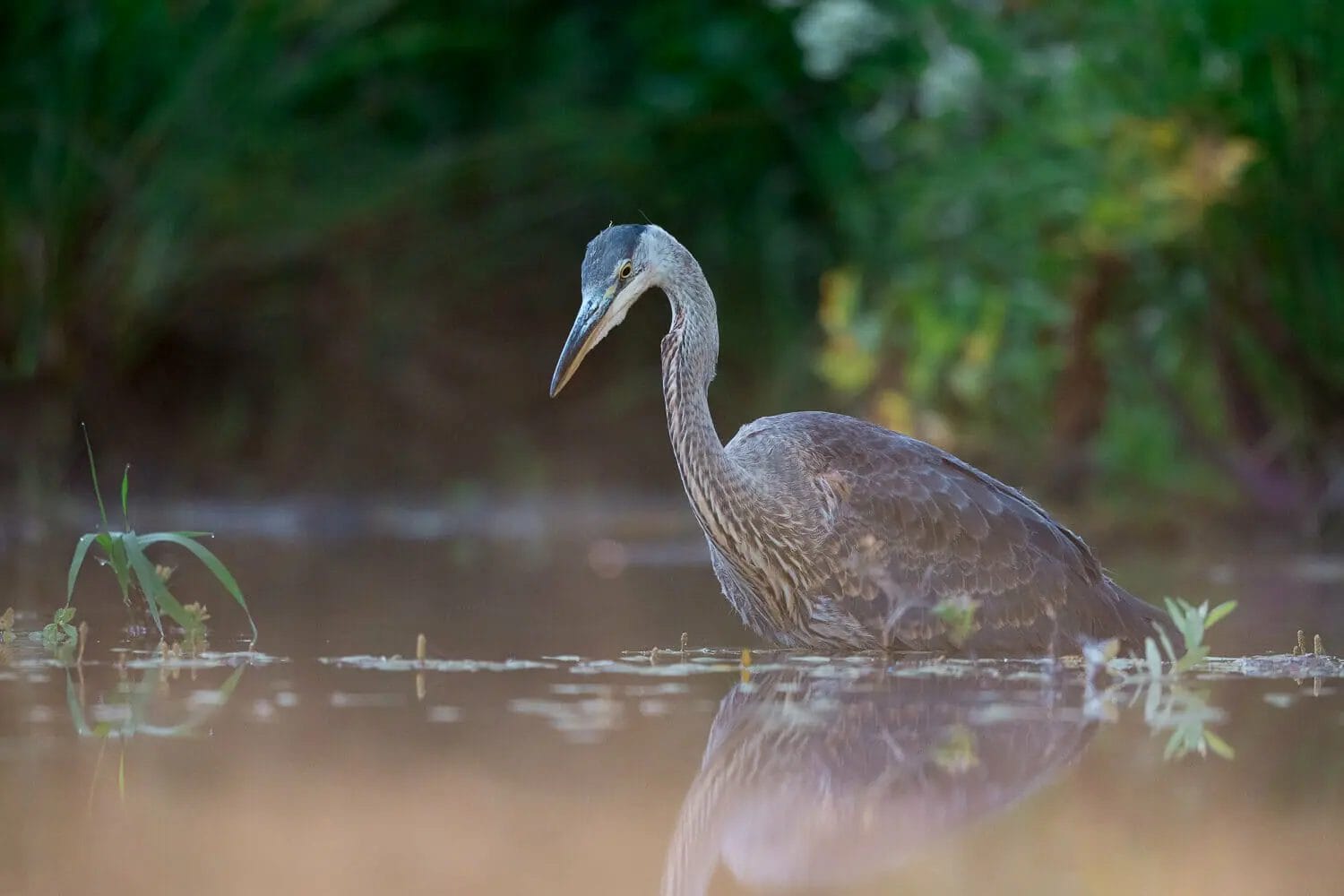
This post contains affiliate links. If you use these links to buy something, we may earn a commission at no additional cost to you. We only recommend products we fully support or use ourselves. Our full disclaimer
What is a photo essay?
- Photo essays vs photo stories
- How photo essays help you
- 9 Steps to create photo essays
How to share your photo essays
Read Time: 11 minutes
Gather up a handful of images that seem to go together, and voila! It’s a photo essay, right? Well… no. Though, this is a common misconception.
In reality, a photo essay is much more thoughtful and structured than that. When you take the time to craft one, you’re using skills from all facets of our craft – from composition to curation.
In this guide, you’ll learn what makes a photo essay an amazing project that stretches your skills. You’ll also learn exactly how to make one step by step.
- Photo essay vs photo story
A photo essay is a collection of images based around a theme, a topic, a creative approach, or an exploration of an idea. Photo essays balance visual variety with a cohesive style and concept.
What’s the difference between a photo essay and a photo story?
The terms photo essay and photo story are often used interchangeably. Even the dictionary definition of “photo essay” includes using images to convey either a theme or a story.
But in my experience, a photo essay and a photo story are two different things. As you delve into the field of visual storytelling, distinguishing between the two helps you to take a purposeful approach to what you’re making .
The differences ultimately lie in the distinctions between theme, topic and story.
Themes are big-picture concepts. Example: Wildness
Topics are more specific than themes, but still overarching. Example : Wild bears of Yellowstone National Park
Stories are specific instances or experiences that happen within, or provide an example for, a topic or theme. Example: A certain wild bear became habituated to tourists and was relocated to maintain its wildness
Unlike a theme or topic, a story has particular elements that make it a story. They include leading characters, a setting, a narrative arc, conflict, and (usually) resolution.
With that in mind, we can distingush between a photo essay and a photo story.
Themes and Topics vs Stories
A photo essay revolves around a topic, theme, idea, or concept. It visually explores a big-picture something .
This allows a good deal of artistic leeway where a photographer can express their vision, philosophies, opinions, or artistic expression as they create their images.
A photo story is a portfolio of images that illustrate – you guessed it – a story.
Because of this, there are distinct types of images that a photo story uses that add to the understanding, insight, clarity and meaning to the story for viewers. While they can certainly be artistically crafted and visually stunning, photo stories document something happening, and rely on visual variety for capturing the full experience.
A photo essay doesn’t need to have the same level of structured variety that a photo story requires. It can have images that overlap or are similar, as they each explore various aspects of a theme.
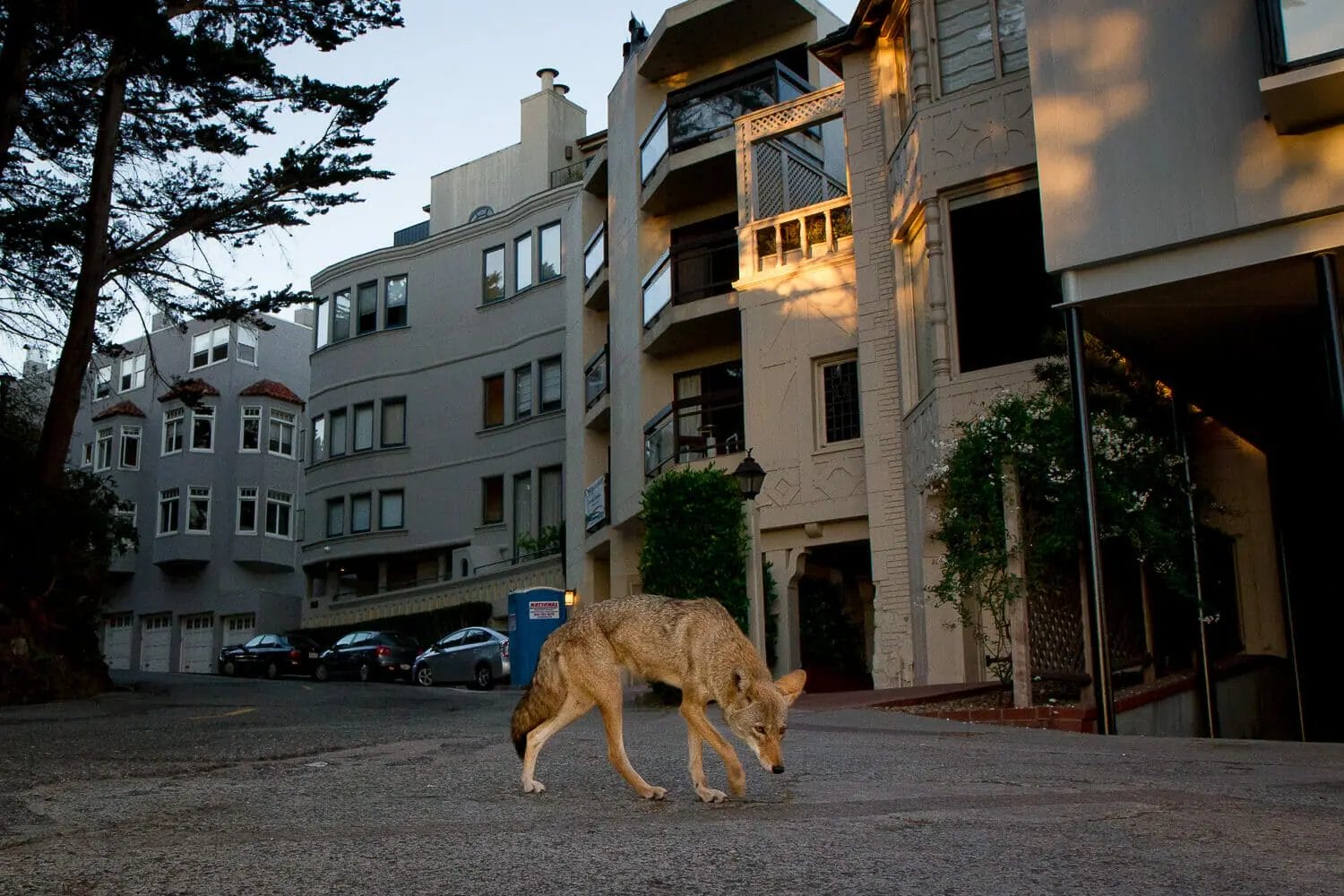
Photo essays can be about any topic. If you live in a city, consider using your nature photography to make an essay about the wildlife that lives in your neighborhood .
The role of text with photos
A photo story typically runs alongside text that narrates the story. We’re a visual species, and the images help us feel like we are there, experiencing what’s happening. So, the images add significant power to the text, but they’re often a partner to it.
This isn’t always the case, of course. Sometimes photo stories don’t need or use text. It’s like reading a graphic novel that doesn’t use text. Moving through the different images that build on each other ultimately unveils the narrative.
Photo essays don’t need to rely on text to illuminate the images’ theme or topic. The photographer may use captions (or even a text essay), or they may let the images speak for themselves.
Definitions are helpful guidelines (not strict rules)
Some people categorize photo essays as either narrative or thematic. That’s essentially just calling photo stories “narrative photo essays” and photo essays “thematic photo essays.”
But, a story is a defined thing, and any writer/editor will tell you themes and topics are not the same as stories. And we use the word “story” in our daily lives as it’s defined. So, it makes far more sense to name the difference between a photo essay and a photo story, and bask in the same clarity writers enjoy .
Photo stories illustrate a particular experience, event, narrative, something that happened or is happening.
Photo essays explore an idea, concept, topic, theme, creative approach, big-picture something .
Both photo essays and photo stories are immensely powerful visual tools. And yes, the differences between them can certainly be blurred, as is always the case with art.
Simply use this distinction as a general guideline, providing extra clarity around what you’re making and why you’re making it.
To dig into specific types of images used to create powerful photo stories, check out this training: 6 Must-Have Shots for a Photo Story.
Meanwhile, let’s dig deeper into photo essays.

Capturing amazing wildlife photos requires not only passion and skill but also the right equipment.
This guide breaks down the best options so you can find the perfect camera for your specific needs , whether you're a beginner or pro.
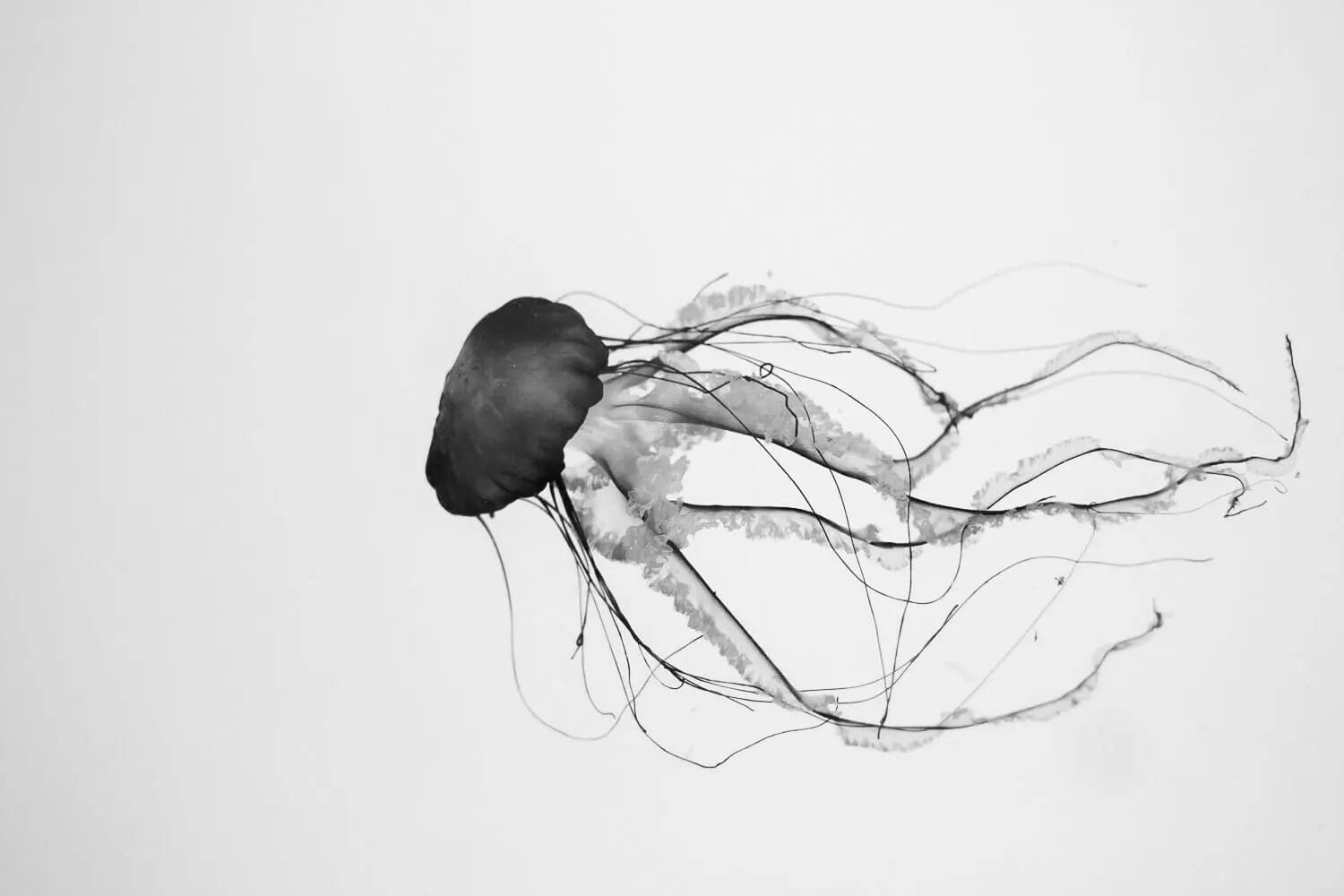
Photo essays are a chance to try new styles or techniques that stretch your skills and creativity. This image was part of an essay exploring simplicity and shape, and helped me learn new skills in black and white post-processing.
How photo essays improve your photography
Creating photo essays is an amazing antidote if you’ve ever felt a lack of direction or purpose in your photography. Photo essays help build your photographic skills in at least 3 important ways.
1. You become more strategic in creating a body of work
It’s easy to get stuck in a rut of photographing whatever pops up in front of you. And when you do, you end up with a collection of stand-alone shots.
These singles may work fine as a print, a quick Instagram post, or an addition to your gallery of shots on your website. But amassing a bunch of one-off shots limits your opportunities as a photographer for everything from exhibits to getting your work published.
Building photo essays pushes you to think strategically about what you photograph, why, and how. You’re working toward a particular deliverable – a cohesive visual essay – with the images you create.
This elevates your skills in crafting your photo essay, and in how you curate the rest of your work, from galleries on your website to selecting images to sell as prints .
2. You become more purposeful in your composition skills
Composition is so much more than just following the rule of thirds, golden spirals, or thinking about the angle of light in a shot.
Composition is also about thinking ahead in what you’re trying to accomplish with a photograph – from what you’re saying through it to its emotional impact on a viewer – and where it fits within a larger body of work.
Photo essays push you to think critically about each shot – from coming up with fresh compositions for familiar subjects, to devising surprising compositions to fit within a collection, to creating compositions that expand on what’s already in a photo essay.
You’re pushed beyond creating a single pleasing frame, which leads you to shoot more thoughtfully and proactively than ever.
(Here’s a podcast episode on switching from reactive shooting to proactive shooting .)
3. You develop strong editing and curation skills
Selecting which images stay, and which get left behind is one of the hardest jobs on a photographer’s to-do list. Mostly, it’s because of emotional attachment.
You might think it’s an amazing shot because you know the effort that went into capturing it. Or perhaps when you look at it, you get a twinge of the joy or exhilaration you felt the moment you captured it. There’s also the second-guessing that goes into which of two similar images is the best – which will people like more? So you’re tempted to just show both.
Ultimately, great photographers appear all the more skilled because they only show their best work. That in and of itself is a skill they’ve developed through years of ruthlessly editing their own work.
Because the most powerful photo essays only show a handful of extraordinary images, you’re bound to develop the very same critical skill (and look all the more talented because of it).
Photo essays are also a great stepping stone to creating photo stories. If you’re interested in moving beyond stand-alone shots and building stories, shooting photo essays will get your creative brain limbered up and ready for the adventure of photo stories.
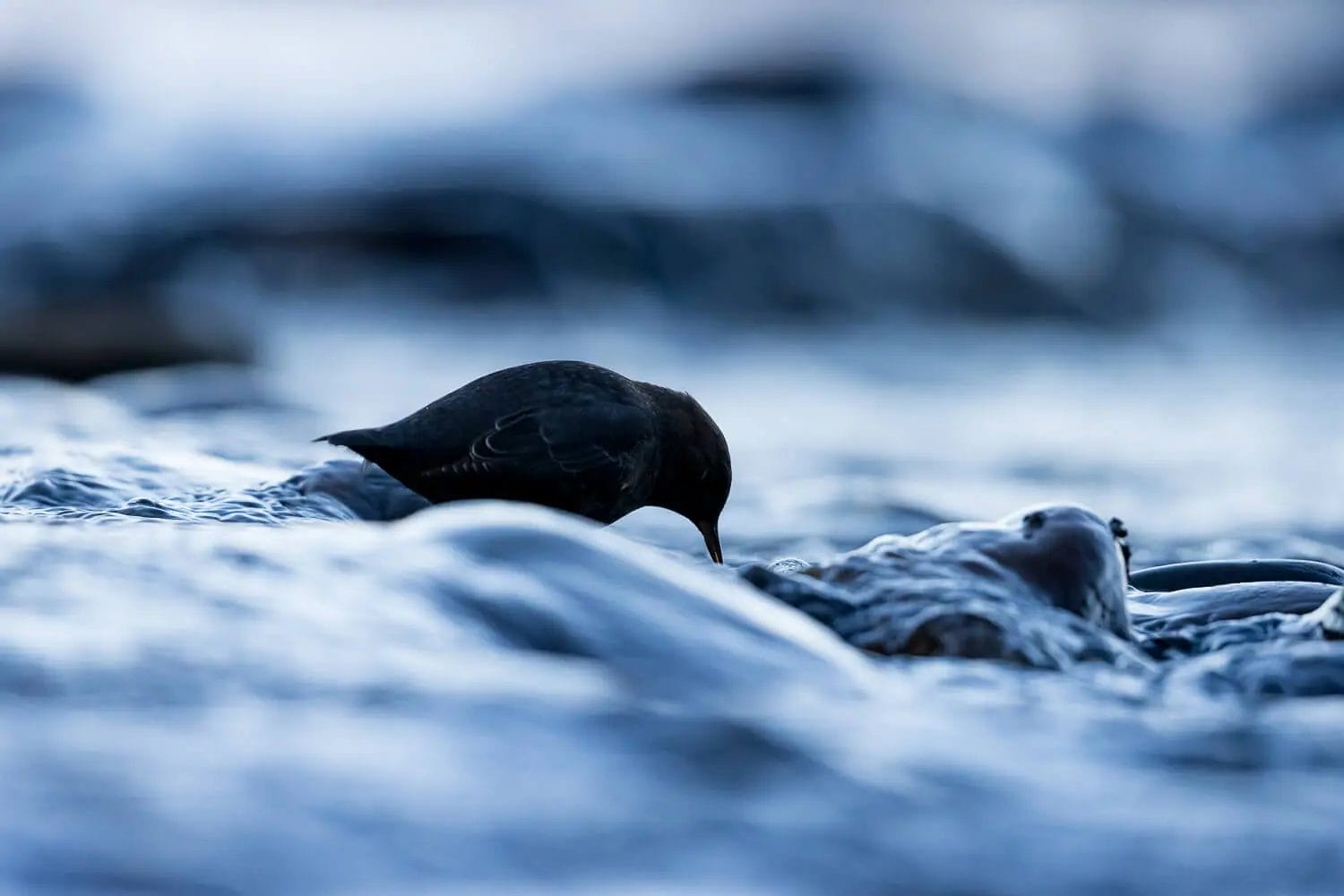
A photo essay exploring the natural history of a favorite species is an exciting opportunity for an in-depth study. For me, that was a photo essay on emotive images of the American dipper (Cinclus mexicanus) as it hunts in streams.
9 Simple steps to create your photo essays
1. clarify your theme.
Choose a theme, topic, or concept you want to explore. Spend some time getting crystal clear on what you want to focus on. It helps to write out a few sentences, or even a few paragraphs noting:
- What you want the essay to be about
- What kinds of images you want to create as part of it
- How you’ll photograph the images
- The style, techniques, or gear you might use to create your images
- What “success” looks like when you’re done with your photo essay
You don’t have to stick to what you write down, of course. It can change during the image creation process. But fleshing your idea out on paper goes a long way in clarifying your photo essay theme and how you’ll go about creating it.
2. Create your images
Grab your camera and head outside!
As you’re photographing your essay, allow yourself some freedom to experiment. Try unusual compositions or techniques that are new to you.
Stretch your style a little, or “try on” the style of other photographers you admire who have photographed similar subjects.
Photo essays are wonderful opportunities to push yourself outside of your comfort zone and grow as a photographer .
Remember that a photo essay is a visually cohesive collection of images that make sense together. So, while you might stretch yourself into new terrain as you shoot, try to keep that approach, style, or strategy consistent.
Don’t be afraid to create lots of images. It’s great to have lots to choose from in the editing process, which comes up next.
3. Pull together your wide edit
Once you’ve created your images, pull together all the images that might make the cut. This could be as many as 40-60 images. Include anything you want to consider for the final essay in the wide edit.
From here, start weeding out images that:
- are weaker in composition or subject matter
- stand out like a sore thumb from the rest of the collection
- Are similar to other stronger images in the collection
It’s helpful to review the images at thumbnail size. You make more instinctive decisions and can more easily see the body of work as a whole. If an image is strong even at thumbnail size to stand out from similar frames while also partnering well with other images in the collection, that’s a good sign it’s strong enough for the essay.
4. Post-process your images for a cohesive look
Now it’s time to post-process the images. Use whatever editing software you’re comfortable with to polish your images.
Again, a photo essay has a cohesive visual look. If you use presets, filters, or other tools, use them across all the images.
5. Finalize your selection
It’s time to make the tough decisions. Select only the strongest for your photo essay from your group of images.
Each image should be strong enough to stand on its own and make sense as part of the whole group.
Many photo essays range from 8-12 images. But of course, it varies based on the essay. The number of images you have in your final photo essay is up to you.
Remember, less is more. A photo essay is most powerful when each image deserves to be included.
6. Put your images in a purposeful order
Create a visual flow with your images. Decide which image is first, and build from there. Use compositions, colors, and subject matter to decide which image goes next, then next, then next in the order.
Think of it like music: notes are arranged in a way that builds energy, or slows it down, surprise listeners with a new refrain, or drop into a familiar chorus. How the notes are ordered creates emotional arcs for listeners.
How you order your images is similar.
Think of the experience a viewer will have as they look at one image, then the next, and the next. Order your images so they create the experience you want your audience to have.
7. Get feedback
The best photographers make space for feedback, even when it’s tough to hear. Your work benefits from not just hearing feedback, but listening to it and applying what you learn from it.
Show your photo essay to people who have different sensibilities or tastes. Friends, family members, fellow photographers – anyone you trust to give you honest feedback.
Watch their reactions and hear what they say about what they’re seeing. Use their feedback to guide you in the next step.
8. Refine, revise, and finalize
Let your photo essay marinate for a little while. Take a day or two away from it. Then use your freshened eyes and the feedback you received from the previous step to refine your essay.
Swap out any selects you might want to change and reorder the images if needed.
9. Add captions
Even if you don’t plan on displaying captions with your images, captioning your images is a great practice to get into. It gives context, story, and important information to each image. And, more than likely, you will want to use these captions at some point when you share your photo essay, which we dive into later in this article.
Add captions to the image files using Lightroom, Bridge, or other software programs.
Create a document, such as a Google or Word doc, with captions for each image.
In your captions, share a bit about the story behind the image, or the creation process. Add whatever makes sense to share that provides a greater understanding of the image and its purpose.
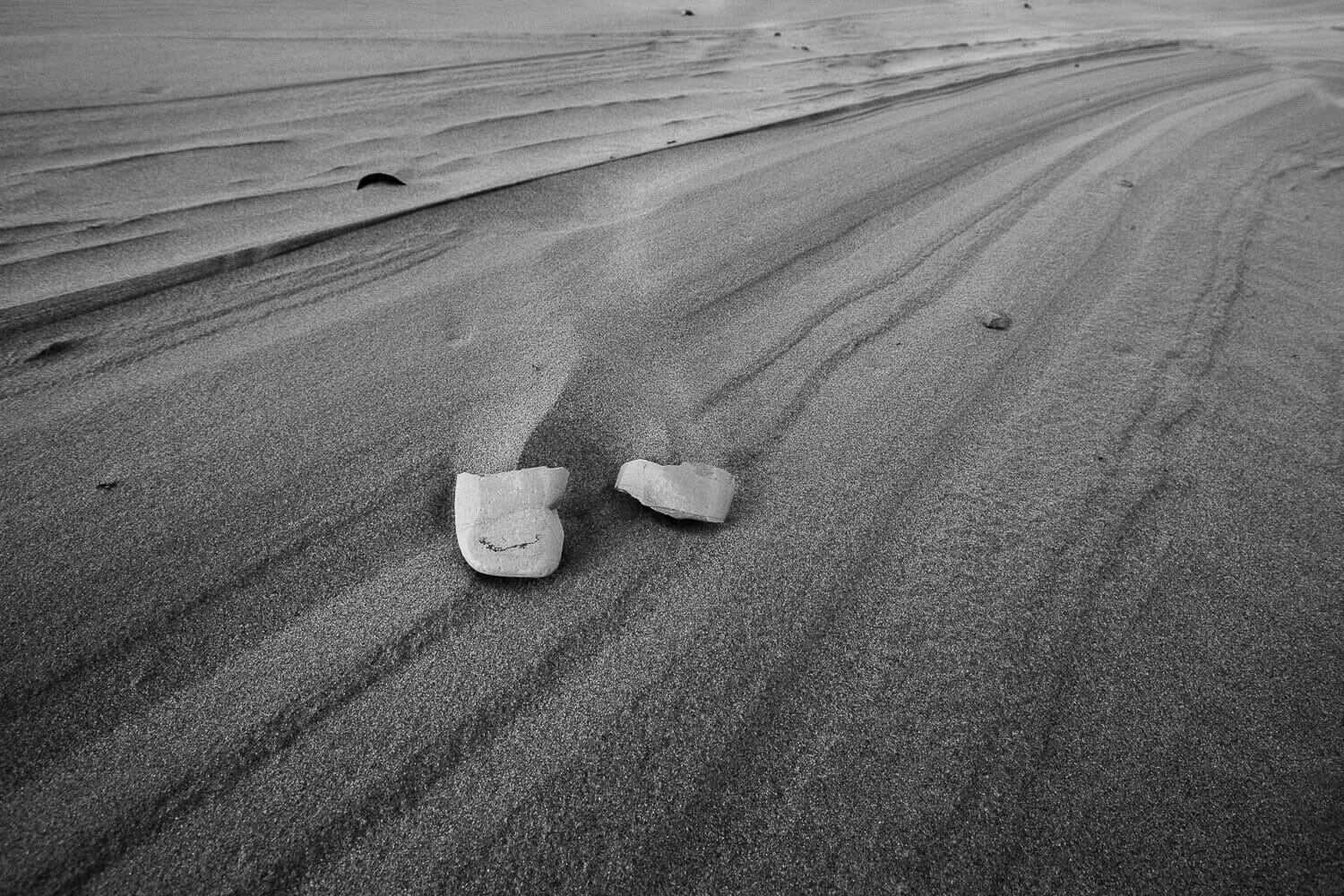
Photo essays allow you to explore deliberate style choices, such as a focus on shapes, patterns, textures, and lines. Since each photo is part of a larger essay, it encourages you to be bold with choices you might not otherwise make.
5 Examples of amazing nature photo essays
1. “how the water shapes us” from the nature conservancy.
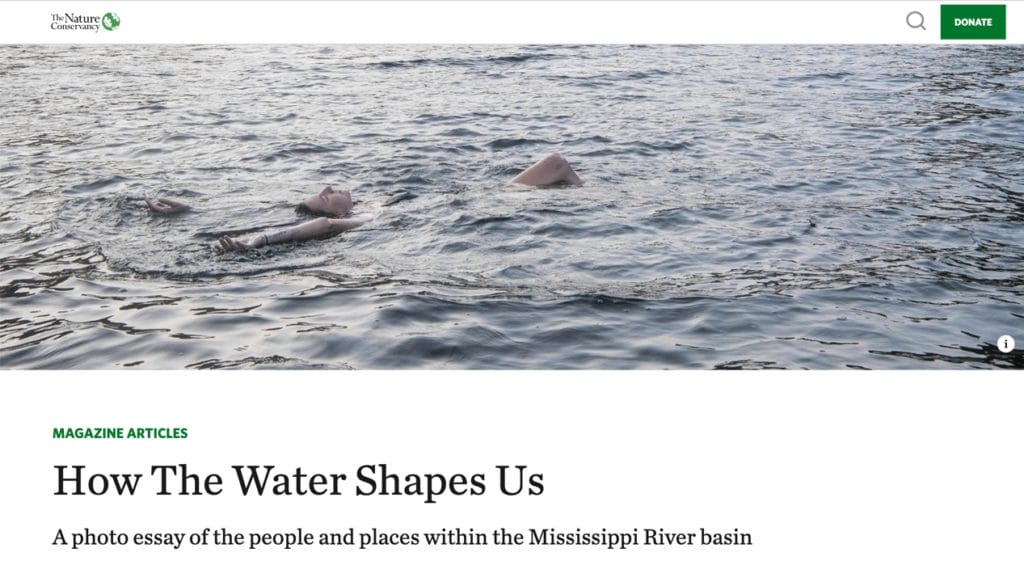
This gorgeous essay, crafted with the work of multiple photographers, explores the people and places within the Mississippi River basin. Through the images, we gain a sense of how the water influences life from the headwater all the way to the Gulf of Mexico. Notice how each photographer is tasked with the same theme, yet approaches it with their own distinct style and vision. It is a wonderful example of the sheer level of visual variety you can have while maintaining a consistent style or theme.
View it here
2. “A Cyclist on the English Landscape” from New York Times’ The World Through A Lens series
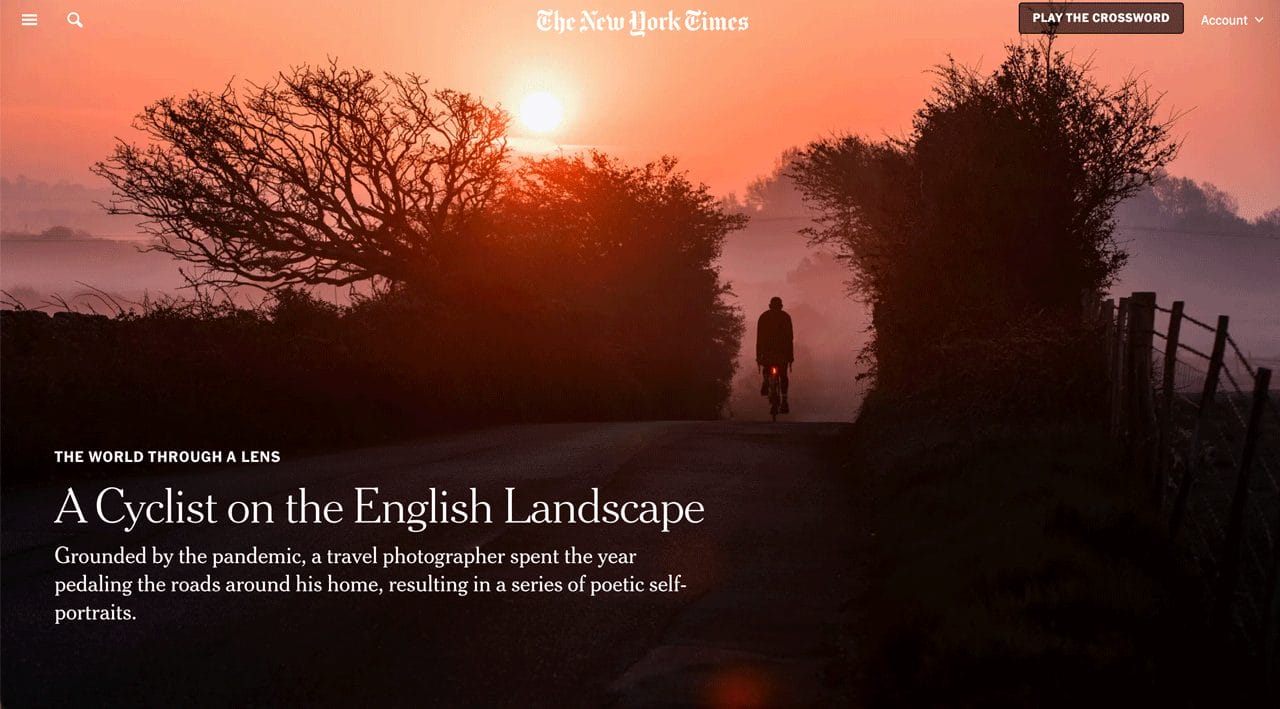
This photo essay is a series of self-portraits by travel photographer Roff Smith while “stuck” at home during the pandemic. As he peddled the roads making portraits, the project evolved into a “celebration of traveling at home”. It’s a great example of how visually consistent you can be inside a theme while making each image completely unique.
3. “Vermont, Dressed In Snow” from New York Times’ The World Through A Lens series
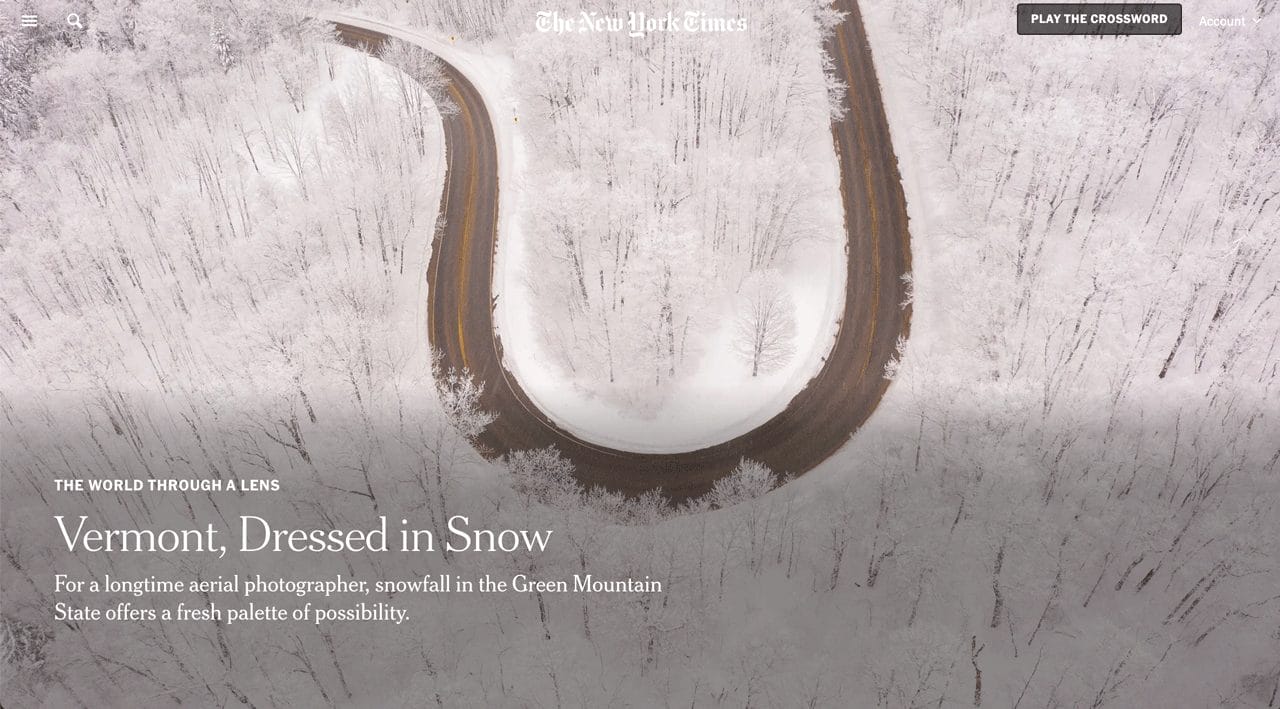
This essay by aerial photographer Caleb Kenna uses a very common photo essay theme: snow. Because all images are aerial photographs, there’s a consistency to them. Yet, the compositions are utterly unique from one another. It’s a great example of keeping viewers surprised as they move from one image to the next while still maintaining a clear focus on the theme.
4. “Starling-Studded Skies” from bioGraphic Magazine
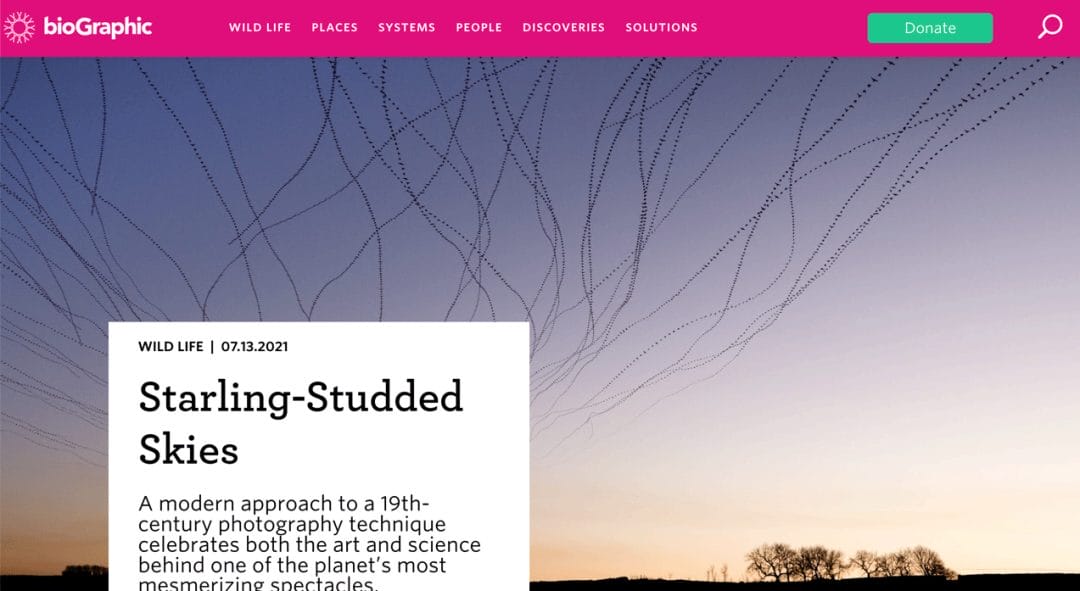
This beautiful essay is by Kathryn Cooper, a physicist trained in bioinformatics, and a talented photographer. She used a 19th century photographic technique, chronophotography, to create images that give us a look at the art and science of starling murmurations. She states: “I’m interested in the transient moments when chaos briefly changes to order, and thousands of individual bodies appear to move as one.” This essay is a great example of deep exploration of a concept using a specific photographic technique.
View it here (Note: must be viewed on desktop)
5. “These Scrappy Photos Capture the Action-Packed World Beneath a Bird Feeder” from Audubon Magazine
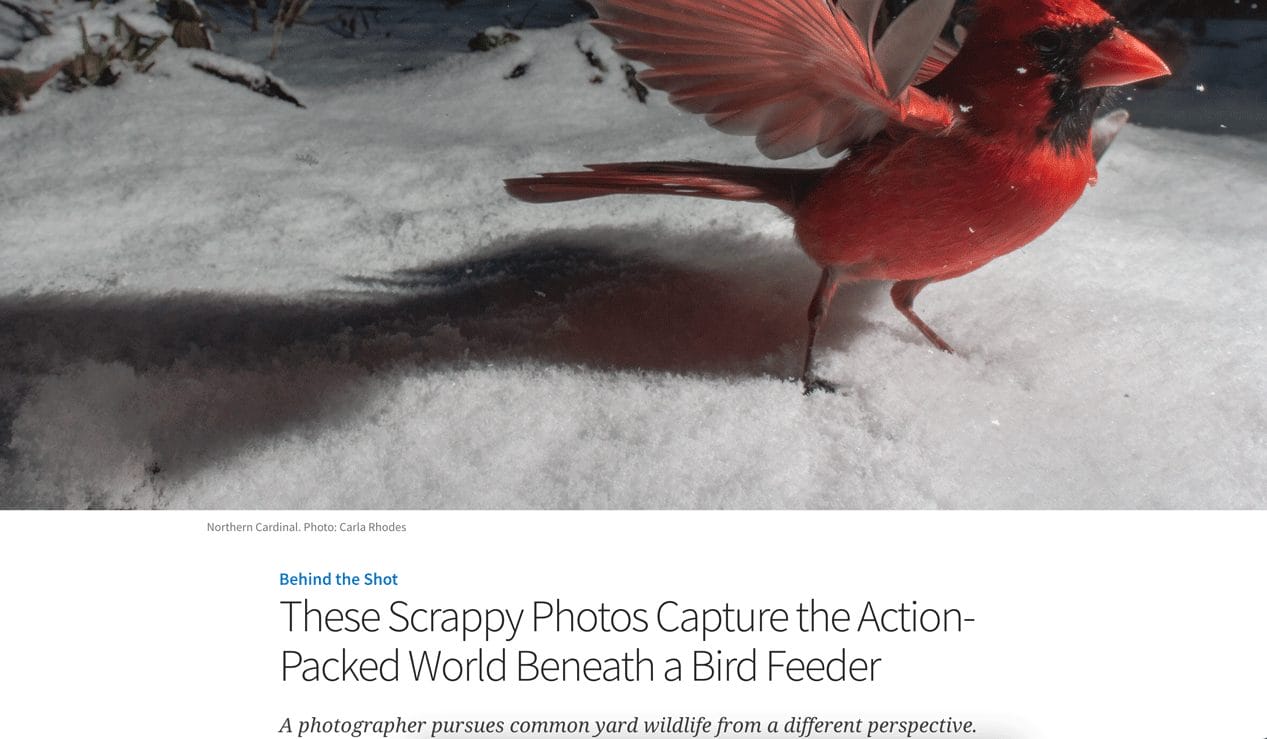
This photo essay from conservation photographer Carla Rhodes explores the wildlife that takes advantage of the bounty of food waiting under bird feeders . Using remote camera photography , Rhodes gives viewers a unique ground-level perspective and captures moments that make us feel like we’re in conversation with friends in the Hundred Acre Woods. This essay is a great example of how perspective, personality, and chance can all come into play as you explore both an idea and a technique.
25 Ideas for creative photo essays you can make
The possibilities for photo essays are truly endless – from the concepts you explore to the techniques you use and styles you apply.
Choose an idea, hone your unique perspective on it, then start applying the 9 simple steps from above.
- The life of a plant or animal (your favorite species, a species living in your yard, etc)
- The many shapes of a single species (a tree species, a bird species, etc)
- How a place changes over time
- The various moods of a place
- A conservation issue you care about
- Math in nature
- Urban nature
- Seasonal changes
- Your yard as a space for nature
- Shifting climate and its impacts
- Human impacts on environments
- Elements: Water, wind, fire, earth
- Day in the life (of a person, a place, a stream, a tree…)
- Outdoor recreation (birding, kayaking, hiking, naturalist journaling…)
- Wildlife rehabilitation
- Lunar cycles
- Sunlight and shadows
- Your local watershed
- Coexistence
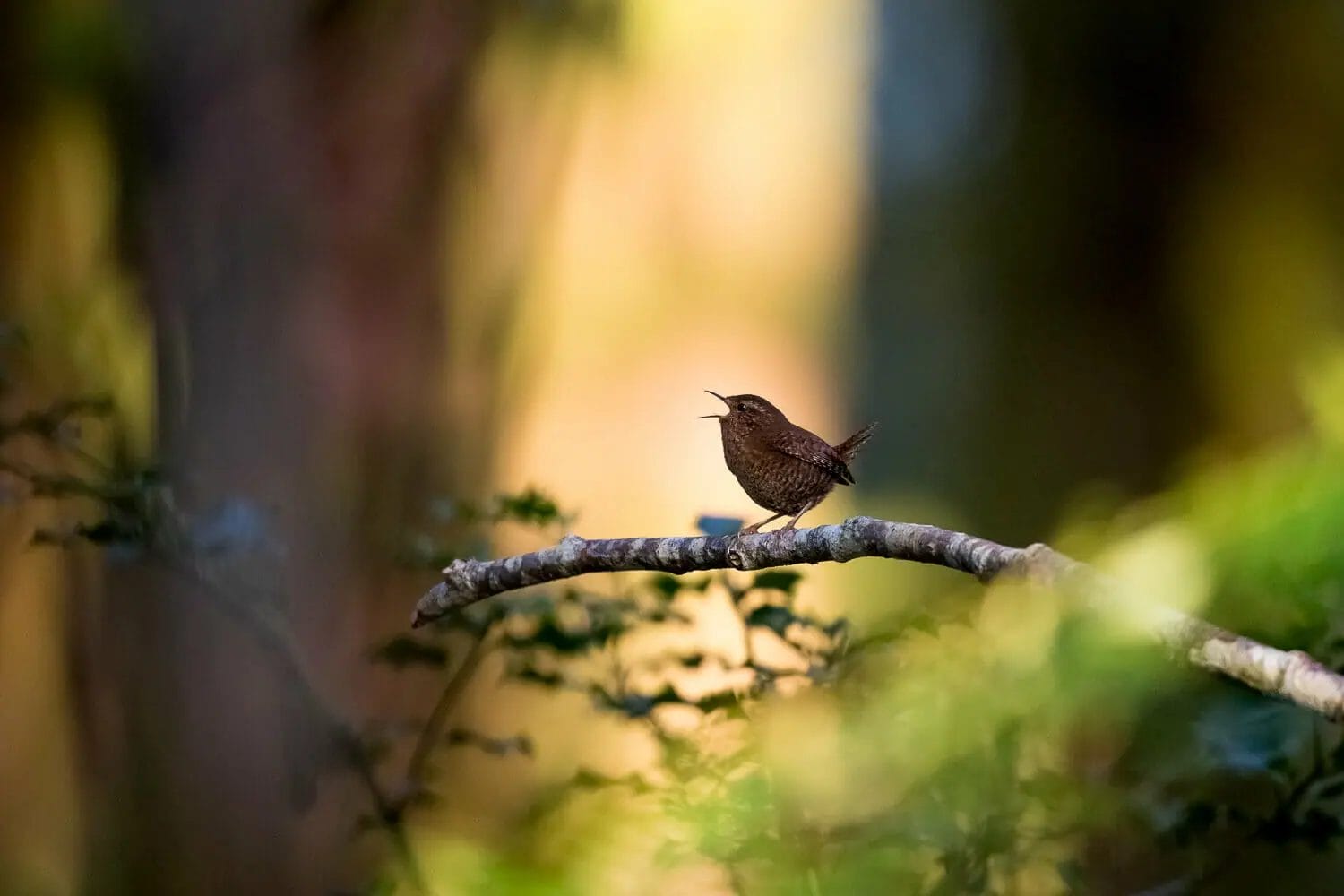
As you zero in on a photo essay theme, consider two things: what most excites you about an idea, and what about it pushes you out of your comfort zone. The heady mix of joy and challenge will ensure you stick with it.
Your photo essay is ready for the world! Decide how you’d like to make an impact with your work. You might use one or several of the options below.
1. Share it on your website
Create a gallery or a scrollytelling page on your website. This is a great way to drive traffic to your website where people can peruse your photo essay and the rest of the photography you have.
Putting it on your website and optimizing your images for SEO helps you build organic traffic and potentially be discovered by a broader audience, including photo editors.
2. Create a scrollytelling web page
If you enjoy the experience of immersive visual experiences, consider making one using your essay. And no, you don’t have to be a whiz at code to make it happen.
Shorthand helps you build web pages with scrollytelling techniques that make a big impression on viewers. Their free plan allows you to publish 3 essays or stories.
3. Create a Medium post
If you don’t have a website and want to keep things simple, a post on Medium is a great option.
Though it’s known for being a platform for bloggers, it’s also possible to add images to a post for a simple scroll.
And, because readers can discover and share posts, it’s a good place for your photos to get the attention of people who might not otherwise come across it.
4. Share it on Instagram
Instagram has changed a lot over the last couple of years, but it’s still a place for photographers to share their work thoughtfully.
There are at least 3 great ways to share your photo essay on the platform.
– Create a single post for each image. Add a caption. Publish one post per day until the full essay is on your feed. Share each post via Instagram Stories to bring more attention and interaction to your photo essay.
– Create a carousel post. You can add up 10 photos to a carousel post, so you may need to create two of them for your full photo essay. Or you might create a series of carousel posts using 3-4 images in each.
– Create a Reel featuring your images as a video. The algorithm heavily favors reels, so turning your photo essay into a video experience can get it out to a larger audience.
I ran a “create a reel” challenge in my membership community. One member created a reel with her still images around a serious conservation issue. It gathered a ton of attention and landed her opportunities to share her message through YouTube and podcast interviews and publishing opportunities. Watch it here.
5. Exhibit it locally
Reach out to local galleries, cafes, pubs, or even the public library to see if they’re interested in hanging your photo essay for display. Many local businesses and organizations happily support the work of local artists.
6. Pitch your photo essay to publications
One of the best ways to reach an audience with your work is to get it published. Find publications that are a great fit for the theme and style of your photo essay, then pitch your essay for consideration. You gain a fantastic opportunity to share your work widely and can earn a paycheck at the same time.
Remember that if you want to get your photo essay published, you may want to hold back from sharing it publicly before you pitch it to publications.
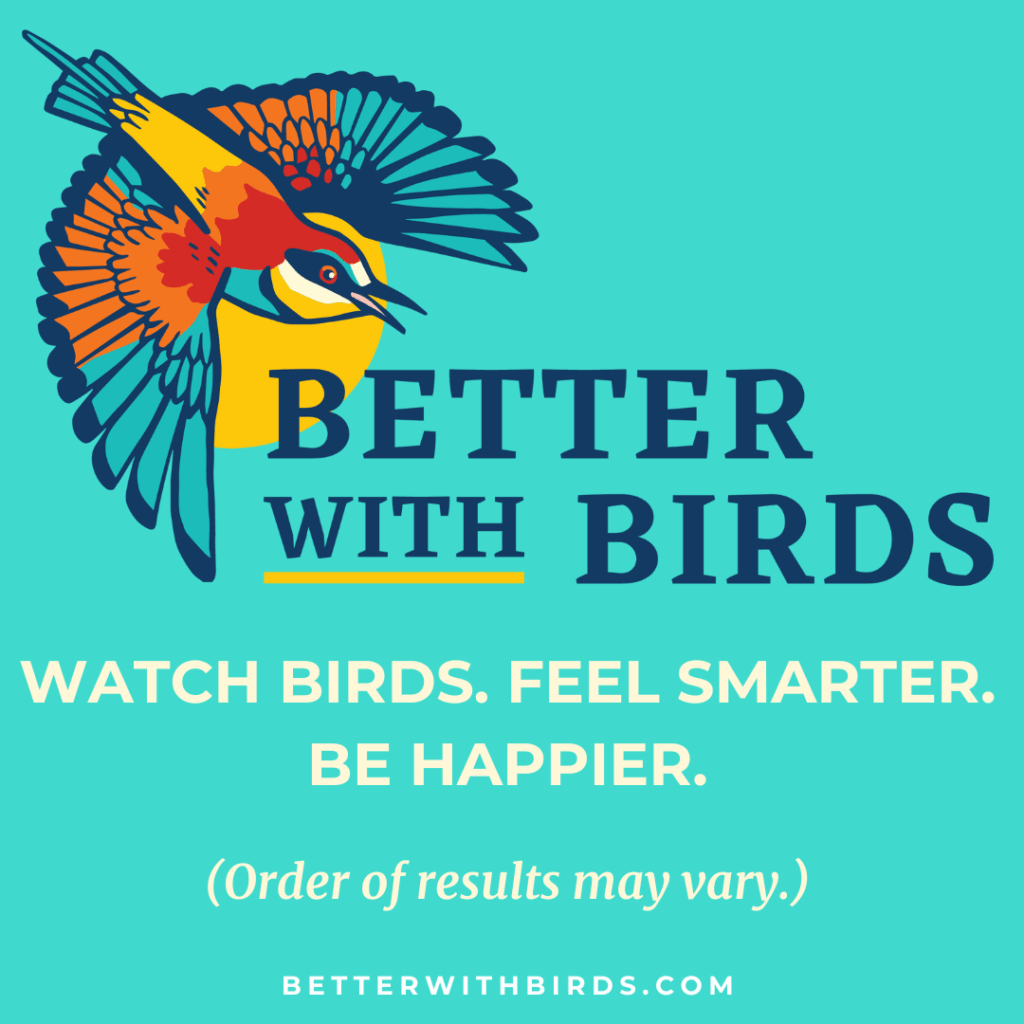
5 Strategies to Find the Positive Angle In Every Conservation Photo Story
Photo Stories and Essays , Tutorials
Training your brain to see the silver linings and solutions is essential in several ways, from engaging your audience to gaining the interest of editors. If you've been watching the news pretty much at all over the past couple of months, you know there's...

How to Make Time for Photography (Even When Life Gets Busy)
Photography Business , Tutorials
It's easy to let your creative time slip to the back burner... or slip off the stove entirely. This surprisingly powerful tool will help you both make time for your photography AND make great forward progress on your projects. Contents Use timed focus...

How to Create Personal Narrative Photo Stories That Viewers LOVE
Your personal perspective and experiences can be a powerful storytelling strategy. But there are ways to do it right (and wrong). Here are my top 3 tips for what to keep in mind when photographing a story that's your own personal narrative so that your story is...

6 Books That Forever Changed My Wildlife Conservation Photography
From how you approach being in the field and scouting locations, to how you approach the stories you photograph and communicate conservation issues, these 6 books are the (unconventional) must-read list for every conservation photographer. An...
PIN THIS FOR LATER

How to train your brain to see solutions in photo stories so that you can engage your audience and gain the interest of editors.

This surprisingly powerful tool will help you both make time for your photography AND make great forward progress on your projects.
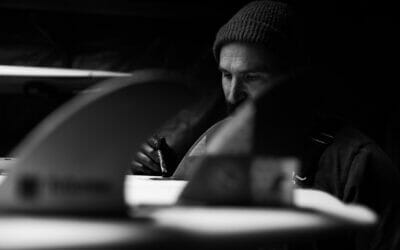
If you do these 3 things, you’ll have a share-worthy story your viewers feel connected to and inspired by.
WHAT DO YOU WANT TO READ TODAY?
POPULAR SEARCHES: Best Cameras | Location Guide | Best Lenses | Wildlife
Privacy Overview
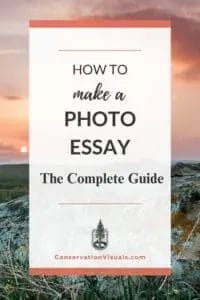
The leading authority in photography and camera gear.
Become a better photographer.
12.9 Million
Annual Readers
Newsletter Subscribers
Featured Photographers
Photography Guides & Gear Reviews

How to Create an Engaging Photo Essay (with Examples)
Photo essays tell a story in pictures. They're a great way to improve at photography and story-telling skills at once. Learn how to do create a great one.
Learn | Photography Guides | By Ana Mireles
Shotkit may earn a commission on affiliate links. Learn more.
Photography is a medium used to tell stories – sometimes they are told in one picture, sometimes you need a whole series. Those series can be photo essays.
If you’ve never done a photo essay before, or you’re simply struggling to find your next project, this article will be of help. I’ll be showing you what a photo essay is and how to go about doing one.
You’ll also find plenty of photo essay ideas and some famous photo essay examples from recent times that will serve you as inspiration.
If you’re ready to get started, let’s jump right in!
Table of Contents
What is a Photo Essay?
A photo essay is a series of images that share an overarching theme as well as a visual and technical coherence to tell a story. Some people refer to a photo essay as a photo series or a photo story – this often happens in photography competitions.
Photographic history is full of famous photo essays. Think about The Great Depression by Dorothea Lange, Like Brother Like Sister by Wolfgang Tillmans, Gandhi’s funeral by Henri Cartier Bresson, amongst others.
What are the types of photo essay?
Despite popular belief, the type of photo essay doesn’t depend on the type of photography that you do – in other words, journalism, documentary, fine art, or any other photographic genre is not a type of photo essay.
Instead, there are two main types of photo essays: narrative and thematic .
As you have probably already guessed, the thematic one presents images pulled together by a topic – for example, global warming. The images can be about animals and nature as well as natural disasters devastating cities. They can happen all over the world or in the same location, and they can be captured in different moments in time – there’s a lot of flexibility.
A narrative photo essa y, on the other hand, tells the story of a character (human or not), portraying a place or an event. For example, a narrative photo essay on coffee would document the process from the planting and harvesting – to the roasting and grinding until it reaches your morning cup.
What are some of the key elements of a photo essay?
- Tell a unique story – A unique story doesn’t mean that you have to photograph something that nobody has done before – that would be almost impossible! It means that you should consider what you’re bringing to the table on a particular topic.
- Put yourself into the work – One of the best ways to make a compelling photo essay is by adding your point of view, which can only be done with your life experiences and the way you see the world.
- Add depth to the concept – The best photo essays are the ones that go past the obvious and dig deeper in the story, going behind the scenes, or examining a day in the life of the subject matter – that’s what pulls in the spectator.
- Nail the technique – Even if the concept and the story are the most important part of a photo essay, it won’t have the same success if it’s poorly executed.
- Build a structure – A photo essay is about telling a thought-provoking story – so, think about it in a narrative way. Which images are going to introduce the topic? Which ones represent a climax? How is it going to end – how do you want the viewer to feel after seeing your photo series?
- Make strong choices – If you really want to convey an emotion and a unique point of view, you’re going to need to make some hard decisions. Which light are you using? Which lens? How many images will there be in the series? etc., and most importantly for a great photo essay is the why behind those choices.
9 Tips for Creating a Photo Essay
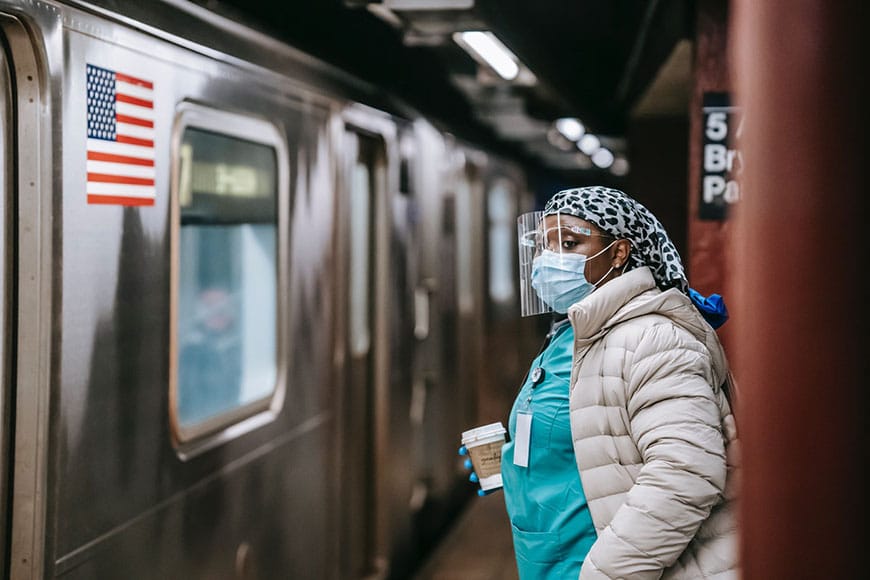
Credit: Laura James
1. Choose something you know
To make a good photo essay, you don’t need to travel to an exotic location or document a civil war – I mean, it’s great if you can, but you can start close to home.
Depending on the type of photography you do and the topic you’re looking for in your photographic essay, you can photograph a local event or visit an abandoned building outside your town.
It will be much easier for you to find a unique perspective and tell a better story if you’re already familiar with the subject. Also, consider that you might have to return a few times to the same location to get all the photos you need.
2. Follow your passion
Most photo essays take dedication and passion. If you choose a subject that might be easy, but you’re not really into it – the results won’t be as exciting. Taking photos will always be easier and more fun if you’re covering something you’re passionate about.
3. Take your time
A great photo essay is not done in a few hours. You need to put in the time to research it, conceptualizing it, editing, etc. That’s why I previously recommended following your passion because it takes a lot of dedication, and if you’re not passionate about it – it’s difficult to push through.
4. Write a summary or statement
Photo essays are always accompanied by some text. You can do this in the form of an introduction, write captions for each photo or write it as a conclusion. That’s up to you and how you want to present the work.
5. Learn from the masters
Making a photographic essay takes a lot of practice and knowledge. A great way to become a better photographer and improve your storytelling skills is by studying the work of others. You can go to art shows, review books and magazines and look at the winners in photo contests – most of the time, there’s a category for photo series.
6. Get a wide variety of photos
Think about a story – a literary one. It usually tells you where the story is happening, who is the main character, and it gives you a few details to make you engage with it, right?
The same thing happens with a visual story in a photo essay – you can do some wide-angle shots to establish the scenes and some close-ups to show the details. Make a shot list to ensure you cover all the different angles.
Some of your pictures should guide the viewer in, while others are more climatic and regard the experience they are taking out of your photos.
7. Follow a consistent look
Both in style and aesthetics, all the images in your series need to be coherent. You can achieve this in different ways, from the choice of lighting, the mood, the post-processing, etc.
8. Be self-critical
Once you have all the photos, make sure you edit them with a good dose of self-criticism. Not all the pictures that you took belong in the photo essay. Choose only the best ones and make sure they tell the full story.
9. Ask for constructive feedback
Often, when we’re working on a photo essay project for a long time, everything makes perfect sense in our heads. However, someone outside the project might not be getting the idea. It’s important that you get honest and constructive criticism to improve your photography.
How to Create a Photo Essay in 5 Steps

Credit: Quang Nguyen Vinh
1. Choose your topic
This is the first step that you need to take to decide if your photo essay is going to be narrative or thematic. Then, choose what is it going to be about?
Ideally, it should be something that you’re interested in, that you have something to say about it, and it can connect with other people.
2. Research your topic
To tell a good story about something, you need to be familiar with that something. This is especially true when you want to go deeper and make a compelling photo essay. Day in the life photo essays are a popular choice, since often, these can be performed with friends and family, whom you already should know well.
3. Plan your photoshoot
Depending on what you’re photographing, this step can be very different from one project to the next. For a fine art project, you might need to find a location, props, models, a shot list, etc., while a documentary photo essay is about planning the best time to do the photos, what gear to bring with you, finding a local guide, etc.
Every photo essay will need different planning, so before taking pictures, put in the required time to get things right.
4. Experiment
It’s one thing to plan your photo shoot and having a shot list that you have to get, or else the photo essay won’t be complete. It’s another thing to miss out on some amazing photo opportunities that you couldn’t foresee.
So, be prepared but also stay open-minded and experiment with different settings, different perspectives, etc.
5. Make a final selection
Editing your work can be one of the hardest parts of doing a photo essay. Sometimes we can be overly critical, and others, we get attached to bad photos because we put a lot of effort into them or we had a great time doing them.
Try to be as objective as possible, don’t be afraid to ask for opinions and make various revisions before settling down on a final cut.
7 Photo Essay Topics, Ideas & Examples

Credit: Michelle Leman
- Architectural photo essay
Using architecture as your main subject, there are tons of photo essay ideas that you can do. For some inspiration, you can check out the work of Francisco Marin – who was trained as an architect and then turned to photography to “explore a different way to perceive things”.
You can also lookup Luisa Lambri. Amongst her series, you’ll find many photo essay examples in which architecture is the subject she uses to explore the relationship between photography and space.
- Process and transformation photo essay
This is one of the best photo essay topics for beginners because the story tells itself. Pick something that has a beginning and an end, for example, pregnancy, the metamorphosis of a butterfly, the life-cycle of a plant, etc.
Keep in mind that these topics are linear and give you an easy way into the narrative flow – however, it might be difficult to find an interesting perspective and a unique point of view.
- A day in the life of ‘X’ photo essay
There are tons of interesting photo essay ideas in this category – you can follow around a celebrity, a worker, your child, etc. You don’t even have to do it about a human subject – think about doing a photo essay about a day in the life of a racing horse, for example – find something that’s interesting for you.
- Time passing by photo essay
It can be a natural site or a landmark photo essay – whatever is close to you will work best as you’ll need to come back multiple times to capture time passing by. For example, how this place changes throughout the seasons or maybe even over the years.
A fun option if you live with family is to document a birthday party each year, seeing how the subject changes over time. This can be combined with a transformation essay or sorts, documenting the changes in interpersonal relationships over time.
- Travel photo essay
Do you want to make the jump from tourist snapshots into a travel photo essay? Research the place you’re going to be travelling to. Then, choose a topic.
If you’re having trouble with how to do this, check out any travel magazine – National Geographic, for example. They won’t do a generic article about Texas – they do an article about the beach life on the Texas Gulf Coast and another one about the diverse flavors of Texas.
The more specific you get, the deeper you can go with the story.
- Socio-political issues photo essay
This is one of the most popular photo essay examples – it falls under the category of photojournalism or documental photography. They are usually thematic, although it’s also possible to do a narrative one.
Depending on your topic of interest, you can choose topics that involve nature – for example, document the effects of global warming. Another idea is to photograph protests or make an education photo essay.
It doesn’t have to be a big global issue; you can choose something specific to your community – are there too many stray dogs? Make a photo essay about a local animal shelter. The topics are endless.
- Behind the scenes photo essay
A behind-the-scenes always make for a good photo story – people are curious to know what happens and how everything comes together before a show.
Depending on your own interests, this can be a photo essay about a fashion show, a theatre play, a concert, and so on. You’ll probably need to get some permissions, though, not only to shoot but also to showcase or publish those images.
4 Best Photo Essays in Recent times
Now that you know all the techniques about it, it might be helpful to look at some photo essay examples to see how you can put the concept into practice. Here are some famous photo essays from recent times to give you some inspiration.
Habibi by Antonio Faccilongo
This photo essay wan the World Press Photo Story of the Year in 2021. Faccilongo explores a very big conflict from a very specific and intimate point of view – how the Israeli-Palestinian war affects the families.
He chose to use a square format because it allows him to give order to things and eliminate unnecessary elements in his pictures.
With this long-term photo essay, he wanted to highlight the sense of absence and melancholy women and families feel towards their husbands away at war.
The project then became a book edited by Sarah Leen and the graphics of Ramon Pez.
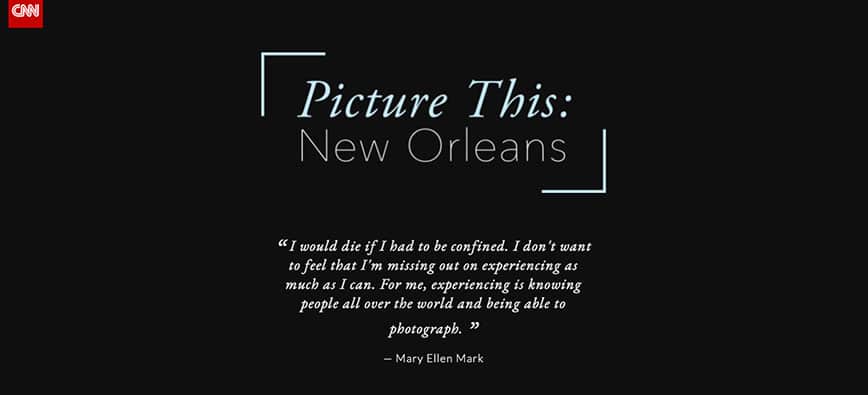
Picture This: New Orleans by Mary Ellen Mark
The last assignment before her passing, Mary Ellen Mark travelled to New Orleans to register the city after a decade after Hurricane Katrina.
The images of the project “bring to life the rebirth and resilience of the people at the heart of this tale”, – says CNNMoney, commissioner of the work.
Each survivor of the hurricane has a story, and Mary Ellen Mark was there to record it. Some of them have heartbreaking stories about everything they had to leave behind.
Others have a story of hope – like Sam and Ben, two eight-year-olds born from frozen embryos kept in a hospital that lost power supply during the hurricane, yet they managed to survive.
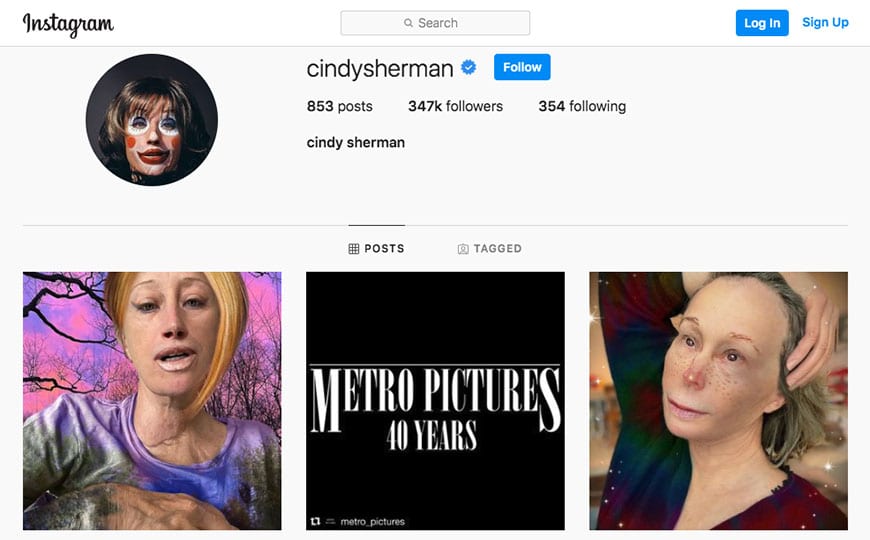
Selfie by Cindy Sherman
Cindy Sherman is an American photographer whose work is mainly done through self-portraits. With them, she explores the concept of identity, gender stereotypes, as well as visual and cultural codes.
One of her latest photo essays was a collaboration with W Magazine entitled Selfie. In it, the author explores the concept of planned candid photos (‘plandid’).
The work was made for Instagram, as the platform is well known for the conflict between the ‘real self’ and the one people present online. Sherman started using Facetune, Perfect365 and YouCam to alter her appearance on selfies – in Photoshop, you can modify everything, but these apps were designed specifically to “make things prettier”- she says, and that’s what she wants to explore in this photo essay.
Tokyo Compression by Michael Wolf
Michael Wolf has an interest in the broad-gauge topic Life in Cities. From there, many photo essays have been derived – amongst them – Tokyo Compression .
He was horrified by the way people in Tokyo are forced to move to the suburbs because of the high prices of the city. Therefore, they are required to make long commutes facing 1,5 hours of train to start their 8+ hour workday followed by another 1,5 hours to get back home.
To portray this way of life, he photographed the people inside the train pressed against the windows looking exhausted, angry or simply absent due to this way of life.
You can visit his website to see other photo essays that revolve around the topic of life in megacities.
Final Words
It’s not easy to make photo essays, so don’t expect to be great at it right from your first project.
Start off small by choosing a specific subject that’s interesting to you – that will come from an honest place, and it will be a great practice for some bigger projects along the line.
Whether you like to shoot still life or you’re a travel photographer, I hope these photo essay tips and photo essay examples can help you get started and grow in your photography.
Let us know which topics you are working on right now – we’ll love to hear from you!

Check out these 8 essential tools to help you succeed as a professional photographer.
Includes limited-time discounts.

Ana Mireles is a Mexican researcher that specializes in photography and communications for the arts and culture sector.
Penelope G. To Ana Mireles Such a well written and helpful article for an writer who wants to inclue photo essay in her memoir. Thank you. I will get to work on this new skill. Penelope G.
Herman Krieger Photo essays in black and white
Leave a Comment Cancel Reply
👋 WELCOME TO SHOTKIT!
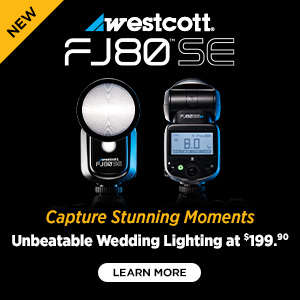
🔥 Popular NOW:

Unlock the EXACT blueprint to capture breathtaking iPhone photos!

Photo Essay
Photo essay generator.
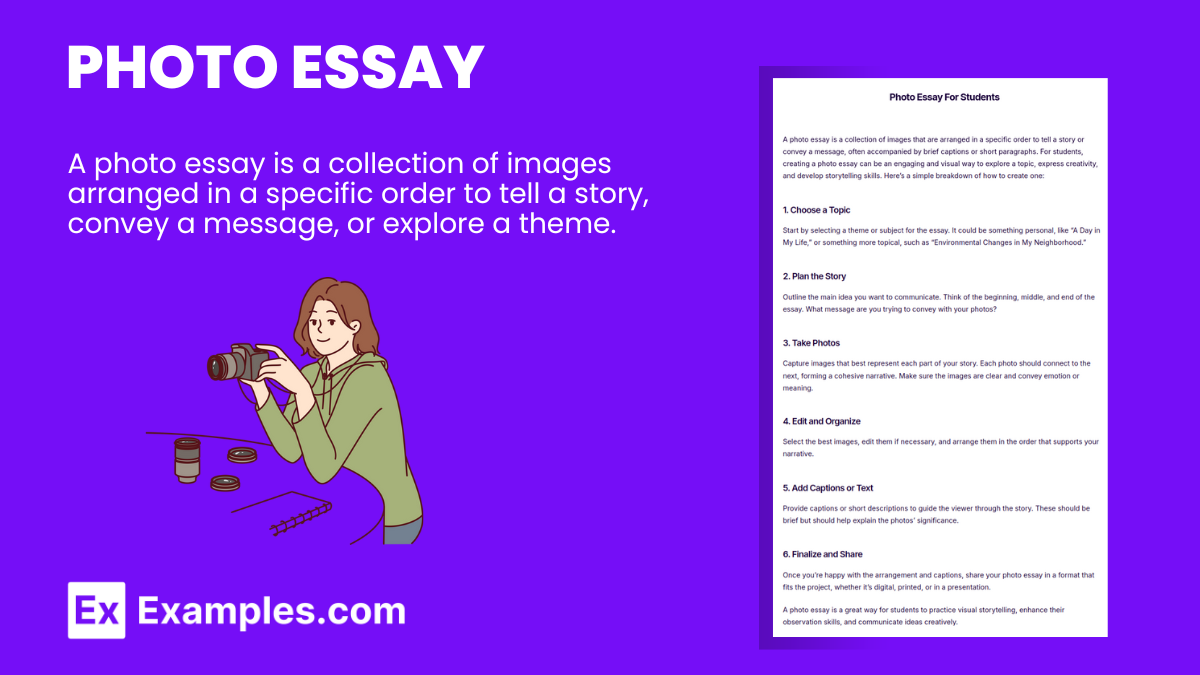
We all know that photographs tell a story. These still images may be seen from various perspectives and are interpreted in different ways. Oftentimes, photographers like to give dramatic meaning to various scenarios. For instance, a blooming flower signifies a new life. Photographs always hold a deeper meaning than what they actually are.
In essay writing , photographs along with its supporting texts, play a significant role in conveying a message. Here are some examples of these kinds of photo-text combinations.
What is Photo Essay?
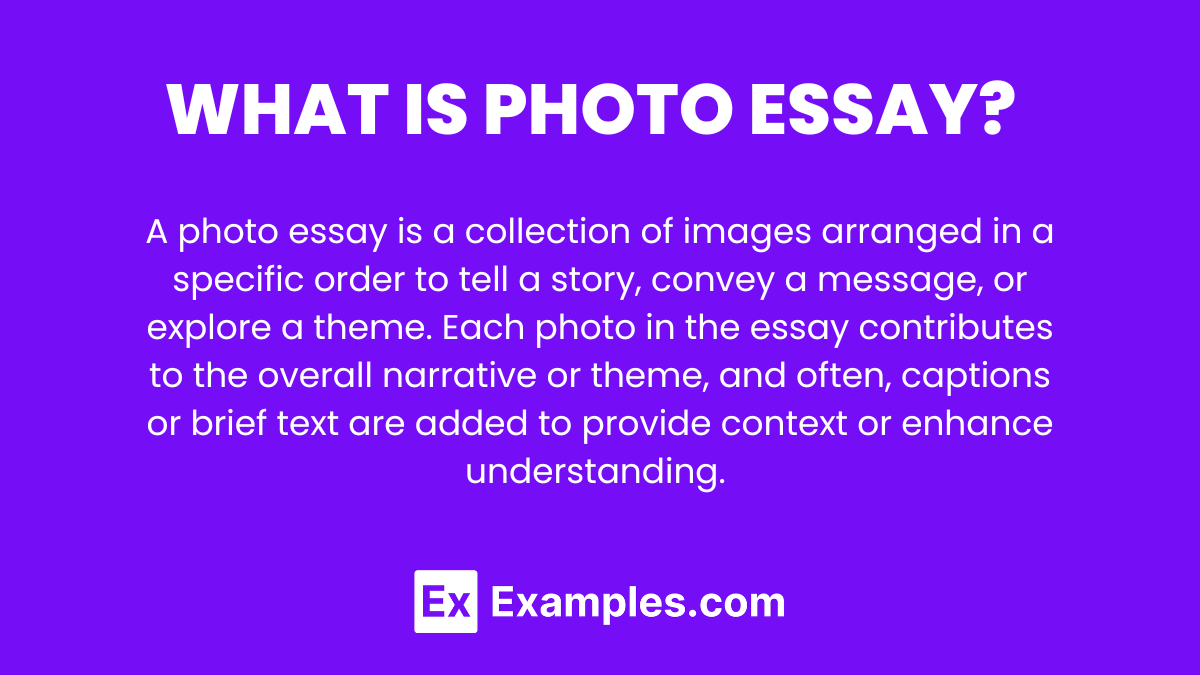
Download Photo Essay Bundle
Photo Essay Format
A photo essay is a series of photographs that are intended to tell a story or evoke a series of emotions in the viewer. It is a powerful way to convey messages without the need for many words. Here is a format to guide you in creating an effective photo essay:
Choose a Compelling Topic
Select a subject that you are passionate about or that you find intriguing. Ensure the topic has a clear narrative that can be expressed visually.
Plan Your Shots
Outline the story you wish to tell. This could involve a beginning, middle, and end or a thematic approach. Decide on the types of shots you need (e.g., wide shots, close-ups, portraits, action shots) to best tell the story.
Take Your Photographs
Capture a variety of images to have a wide selection when editing your essay. Focus on images that convey emotion, tell a story, or highlight your theme.
Edit Your Photos
Select the strongest images that best convey your message or story. Edit for consistency in style, color, and lighting to ensure the essay flows smoothly.
Arrange Your Photos
Order your images in a way that makes sense narratively or thematically. Consider transitions between photos to ensure they lead the viewer naturally through the story.
Include Captions or Text (Optional)
Write captions to provide context, add depth, or explain the significance of each photo. Keep text concise and impactful, letting the images remain the focus.
Present Your Photo Essay
Choose a platform for presentation, whether online, in a gallery, or as a printed booklet. Consider the layout and design, ensuring that it complements and enhances the visual narrative.
Conclude with Impact
End with a strong image or a conclusion that encapsulates the essence of your essay. Leave the viewer with something to ponder , reflecting on the message or emotions you aimed to convey.
Best Photo Essay Example
One notable example of a powerful photo essay is “The Photographic Essay: Paul Fusco’s ‘RFK Funeral Train'” by Paul Fusco. This photo essay captures the emotional journey of the train carrying the body of Robert F. Kennedy from New York to Washington, D.C., after his assassination in 1968. Fusco’s images beautifully and poignantly document the mourning and respect shown by people along the train route. The series is a moving portrayal of grief, unity, and the impact of a historical moment on the lives of ordinary individuals. The photographs are both artistically compelling and deeply human, making it a notable example of the potential for photo essays to convey complex emotions and historical narratives.
Short Photo Essay Example
The day begins quietly, marked by the soft beeping of an alarm clock at 6:00 AM. The dim glow from the screen cuts through the darkness, signaling the start of a new morning. As the alarm fades, a person stretches lazily in bed, basking in the gentle rays of sunlight streaming through the window. The morning light, still soft and golden, fills the room with a sense of calm, signaling the peaceful transition from sleep to wakefulness. Moving into the kitchen, the comforting scent of freshly brewed coffee fills the air. A steaming cup sits on the counter, the warmth rising with every breath of steam. It’s a moment of quiet reflection before the busyness of the day begins. The coffee, simple yet essential, provides a moment of pause, a brief chance to savor the stillness of the morning. Finally, the morning routine wraps up with a quiet sense of readiness. The day ahead is yet to unfold, but these small, simple moments — waking up, stretching, and enjoying a cup of coffee — set the tone for what’s to come, illustrating the peaceful rhythm of a new day.
Photo Essay For Students
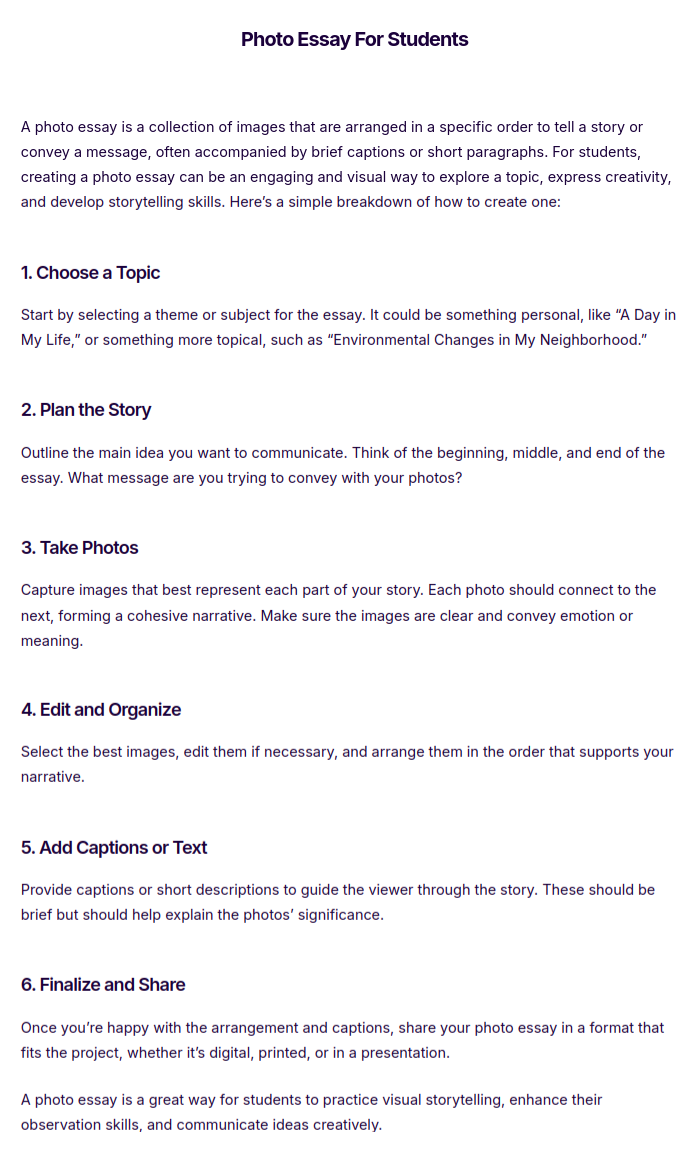
Photo Essay on Nature
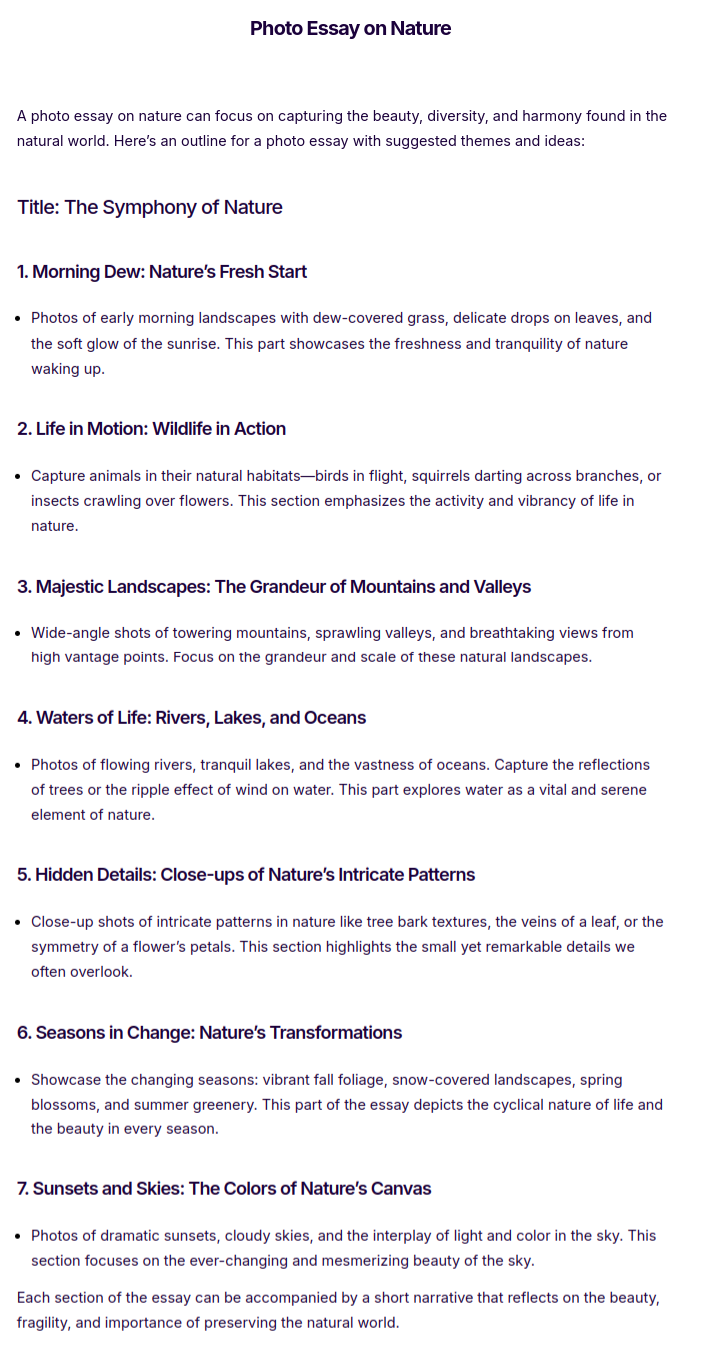
Photo Essay For Kids

Photo Essay Examples & Templates
1. narrative photo essay format example.
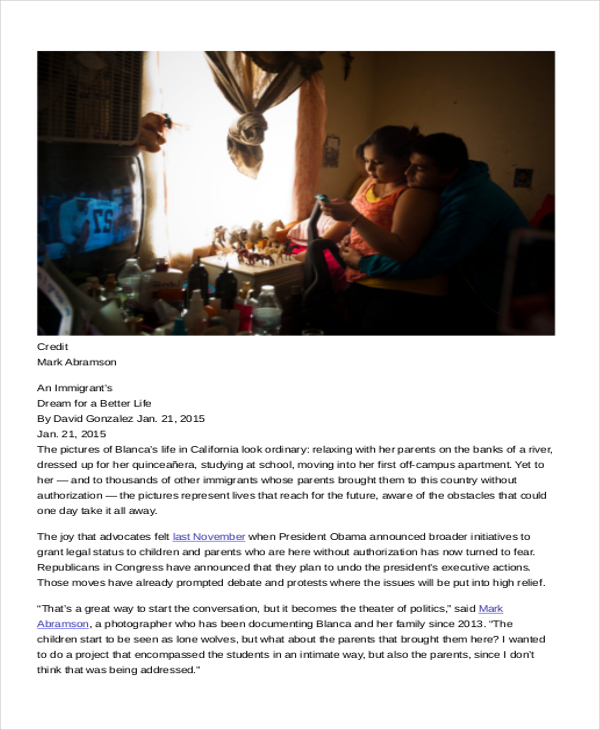
nytimes.com
2. Example of Photo Essay
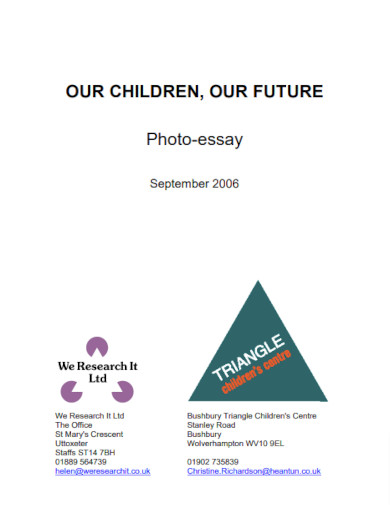
weresearchit.co.uk
3. Travel Photo Essay Example
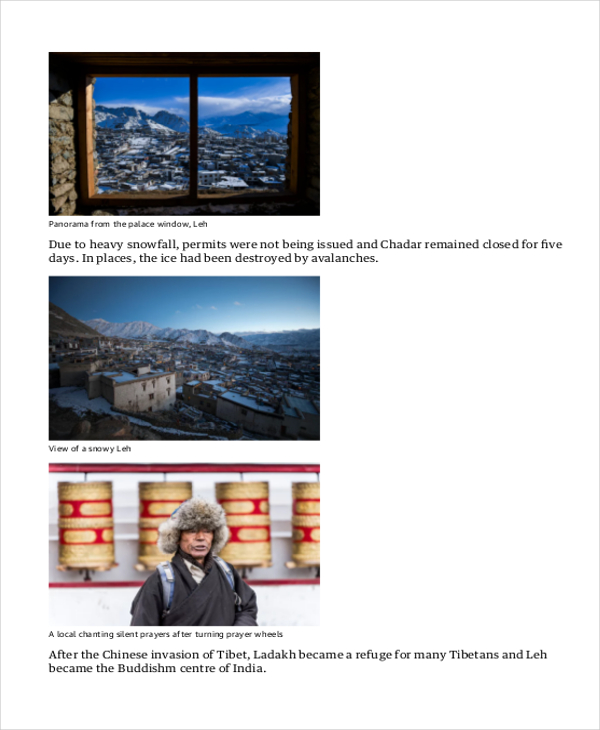
theguardian.com
4. Free Photo Essay Example

vasantvalley.org
5. Photo Essay in PDF
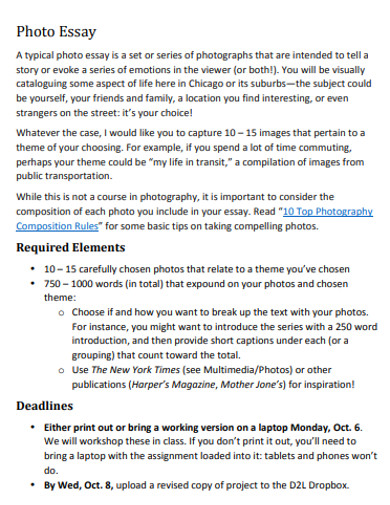
condor.depaul.edu
6. Sample Photo Essay Example
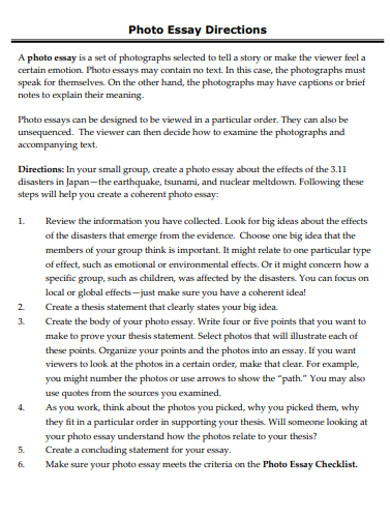
colorado.edu
How to Write Photo Essay?
Writing a photo essay involves using a series of images to tell a cohesive story or convey a message, often supported by brief captions or accompanying text. Here’s a step-by-step guide on how to write a successful photo essay:
Choose a Theme or Topic
Start by selecting a clear subject for your photo essay. It could be an event, a social issue, a personal story, or a particular theme (e.g., urban life, nature, emotions). Make sure it’s a topic you’re passionate about or that resonates with you, as this will influence the depth of your storytelling.
Plan the Structure
Like any narrative, your photo essay should have a beginning, middle, and end. Outline how you want to introduce the story, what key points you want to highlight in the middle, and how you will conclude it. Ensure that the flow between images feels natural and cohesive.
Take or Select Your Photos
Gather images that visually represent your story. If you’re taking the photos, consider the composition, lighting, and emotional impact of each shot. Aim for a variety of perspectives (e.g., wide shots, close-ups) to add depth to your essay.
Write Captions or Accompanying Text
For each photo, write short captions that describe what is happening or enhance the story. The captions can provide context, highlight details, or convey emotions that the photos alone may not express. Keep the text concise and focused.
Edit and Organize the Photos
Review your photos and select the strongest ones that best represent your story. Arrange them in a sequence that flows logically. Each photo should contribute something meaningful to the essay — avoid redundancy or unnecessary shots.
Add a Title and Introduction
Give your photo essay a compelling title that reflects the essence of the story. In the introduction, provide a brief overview of the topic and why it matters, setting the stage for the audience to engage with the photos.
End your essay with a final photo that wraps up the story and reinforces your message. You can add a concluding sentence or paragraph to summarize the theme or leave the viewer with something to reflect on.
Review and Refine
Review the entire essay, ensuring the images and text work together cohesively. Fine-tune the captions, check the order of the photos, and make sure your story flows smoothly from start to finish.

Types of Photo Essay
There are several types of photo essays, each serving a different purpose and employing unique approaches to visual storytelling. Here are some common types:
1. Narrative Photo Essay
- Definition : This type of photo essay tells a story through a sequence of images, similar to a written narrative. The story unfolds over the course of the essay, often with a clear beginning, middle, and end.
- Example : A photo essay documenting a wedding day, from the preparations to the ceremony and reception.
2. Thematic Photo Essay
- Definition : A thematic photo essay focuses on a specific subject, concept, or idea. The photos revolve around the theme, but there’s no strict narrative progression.
- Example : A series of photos capturing different aspects of urban street life, exploring themes like isolation, community, or movement.
3. Documentary Photo Essay
- Definition : This type of essay documents real-life events, people, or places, often in a journalistic or social context. It aims to inform or raise awareness about a particular issue.
- Example : A photo essay covering the effects of climate change on a specific region or community.
4. Portrait Photo Essay
- Definition : A portrait photo essay focuses on a single subject or a group of people, using close-up images to capture expressions, emotions, or personality traits. The essay can explore the subject’s story or identity.
- Example : A series of photos documenting the life of an artist, showing them at work, with their creations, and in their personal space.
5. Event-Based Photo Essay
- Definition : This type of essay documents a specific event, often in real-time, with a series of photos capturing different moments of the event.
- Example : A photo essay of a music festival or a political protest, capturing key moments and the atmosphere.
6. Process Photo Essay
- Definition : A process photo essay shows the step-by-step progression of an activity or event, focusing on how something is done from start to finish.
- Example : A photo essay documenting the process of making traditional pottery, from gathering clay to the final glazed product.
7. Personal Photo Essay
- Definition : A personal photo essay is introspective and often documents the photographer’s own life, thoughts, or experiences. It tends to be more intimate and reflective.
- Example : A self-portrait series capturing personal growth over time, or a travel photo essay of the photographer’s journey through a country.
8. Comparative Photo Essay
- Definition : A comparative photo essay juxtaposes two or more subjects, places, or ideas to highlight contrasts or similarities. It can draw attention to changes over time or differences between cultures.
- Example : A photo essay comparing urban life in two different cities, showcasing differences in architecture, street life, and public spaces.
Each type of photo essay provides a unique way of storytelling, allowing photographers to communicate a message, evoke emotions, or raise awareness about a specific topic or issue.
Importance of Photo Essay
The importance of a photo essay lies in its ability to communicate ideas, emotions, and stories through visual imagery in a compelling and impactful way. Here are some key reasons why photo essays are important:
1. Visual Storytelling
- Photo essays allow for powerful storytelling without relying on words. By using images to tell a story, photo essays engage viewers in a more immediate and emotional way, often conveying complex narratives or concepts that words alone might struggle to express.
2. Engaging and Accessible
- Images are universally understood, making photo essays more accessible to diverse audiences, including those who speak different languages or may have limited literacy. This makes them an excellent medium for broad communication, especially in journalism and social advocacy.
3. Eliciting Emotional Response
- Photos have the power to evoke strong emotional reactions. A well-curated photo essay can make viewers feel empathy, sadness, joy, or outrage, which can create a lasting impression and drive awareness about important issues.
4. Raising Awareness
- Photo essays are often used to highlight social, environmental, or political issues. Through documentary photography, they can bring attention to topics such as poverty, climate change, human rights, or cultural preservation, sparking conversation and inspiring action.
5. Preserving History
- Photo essays document events, people, and cultures, serving as a historical record. By capturing important moments or changes in society, they preserve history for future generations and help people understand the past through a visual lens.
6. Creative Expression
- For photographers and artists, photo essays offer a medium for creative expression. They can explore personal stories, abstract concepts, or artistic themes, providing a platform to showcase their vision and creativity.
7. Enhancing Communication
- In journalism and media, photo essays help convey information quickly and effectively. In combination with text, they provide context and depth to stories, making them more impactful and easier to understand.
8. Influencing Change
- By illustrating real-life issues, photo essays have the power to influence public opinion and policy. Images from conflict zones, protests, or environmental disasters often spark global conversations and motivate people to advocate for change.
In essence, photo essays are important because they bridge the gap between art and communication, making complex subjects more understandable, engaging, and relatable to a wide range of audiences.
Tips for Photo Essay
Here are some tips for crafting a compelling photo essay:
- Choose a clear theme or story : Focus on a central idea or narrative that will guide your photo selection and create cohesion.
- Plan your shots : Think about the types of images you need to tell your story, including wide shots, close-ups, and detailed images.
- Show variety in composition : Use different angles, perspectives, and framing to keep the viewer engaged.
- Ensure emotional connection : Capture moments that evoke emotions and convey the essence of your subject matter.
- Edit carefully : Select only the best photos that contribute to the narrative, ensuring clarity and flow.
- Include captions : Add brief descriptions to provide context or additional insights for each image.
- Consider the sequence : Arrange your photos thoughtfully to create a logical or emotional progression throughout the essay.
1. How do I choose a theme for my photo essay?
Choose a theme that interests you or aligns with your goals. It could be based on social issues, personal experiences, travel, or everyday life. Ensure it has enough depth for visual exploration.
2. How many photos should a photo essay have?
There is no strict rule, but a typical photo essay includes 10–20 photos. Focus on quality and how well each image contributes to the overall story.
3. Do I need to include text in a photo essay?
Yes, captions or brief text can help provide context, explain the narrative, or offer background information. However, the images should carry most of the storytelling weight.
4. Can I use edited or manipulated photos in my essay?
Yes, but the level of editing depends on the purpose of the essay. For journalistic or documentary purposes, minimal editing is preferred to maintain authenticity. For artistic purposes, more creative manipulation might be appropriate.
5. What makes a strong photo essay?
A strong photo essay has a clear narrative, emotional depth, visually diverse images, and effective sequencing. Each image should add to the story, evoke a reaction, and work cohesively with the rest.
6. What are some common mistakes to avoid in a photo essay?
Avoid including too many images, losing focus on your central theme, or failing to create a cohesive story. Also, over-editing your photos can detract from the authenticity of the subject.
Text prompt
- Instructive
- Professional
Create a Photo Essay on the theme of urban exploration.
Discuss the story of a local community event through a Photo Essay.
What is a Photo Essay?

People retain only 10% of information after three days, but adding a photo can increase that to 65%.
That’s why photo essays are in demand in today’s era. But wait! Have you been stuck between dozens of ways to plan a story, or having a hard time picturing everything fitting together, or you may feel like you do not have enough time to do your photo essay assignment, and the list of problems goes on?
The only solution to all your above problems is to learn what is a photo essay, how to write one, what examples of photo essays are, and, lastly, grab some ideas to help you start one on your own. If you follow us, creating this essay is easier than you think. So, without wasting time, let’s get started.
Table of Contents
What is a Photo Essay, and Why Should You Create One?
A photo essay is a collection of photographs shown sequentially alongside textual information to convey a particular message. These essays are often used as creative writing in journalism, documentary photography, and visual storytelling.
Creating photo essays is important because it allows us to communicate with our target audience more effectively through visualizing the events using photographs.
It is also a very popular form of journaling in our image-obsessed society, and journalists know it. Moreover, sometimes high school or college instructors assign photo essays to students. These reasons make it necessary to learn what is a photo essay, and how to create one like a professional.
How To Write a Photo Essay: 11 Well-Worked Easy Steps
A photo essay means telling a story using photographs. Before taking out the step-by-step process, figure out your subject, then decide what the story should be. Lastly, break down the essay into different steps and start writing it. Let’s see how to do it.

Plan Out Your Project.
This is the first and most important step because it helps you decide what photos to take, where to take them, and finally, when to take them. You don’t want to waste your time and money by just going out and clicking photographs that later don’t resonate with your story.
Choose A Topic
Don’t decide quickly or get ideas from others just because you feel you are not sharp-minded. Instead, strengthen your mind and think about what you feel interested in. Also, consider college essay topics to avoid and choose one with enough material to support an entire essay.
Start By Getting Inspiration.
Go on a walk in parks, streets, abundant places, and events and get inspiration from the most exciting things. It can be as easy as taking pictures on an everyday walk to work or taking photos around your neighborhood with your friends. The important thing is that you’re experiencing these places in daily life and have a better understanding of them.
Choose a Style of Photography.
The pictures you take should be relevant to the topic and not random. For example, if you are creating a photo essay on a historical event or building, then providing a vintage or black-and-white effect to your picture could help the reader connect with the story better.
Tell Your Story by Using the Subject.
When learning what is a photo essay, remember that your essay depends entirely on the subject or idea being discussed. What are you trying to say? What’s the point? Why did you choose the particular subject that you did? Answer all these questions in an introduction paragraph to engage the audience from the beginning and make your subject clear to them.
Select a Location
If possible, try to select places that fit the concept. For instance, if you are trying to cover streets at time squares, shooting at night will likely result in chaos rather than anything meaningful. Also, try to capture scenes that look very different from each other.
Angle Shots to Induce Emotions
A photo essay does not just show photos but tells the reader what they represent. Often, professional photographers use different angles while shooting to create deep, stimulating compositions. For example, if you are writing a photo essay about a school event, taking photo shots from above and below could make the event activities colorful and dramatic.
Use Props That Enhance the Subject.
Sometimes, a picture focuses on a specific theme, but by adding props, you can enhance the tone and understanding of the picture. Let’s say you are capturing photographs of an abundant building; adding props like knives, axes, chainsaws, castles, and graveyards can transform what is a photo essay on an abundant place into a horror place.
Write Eye-Catchy Captions
Photo essays consist of two main components: One is a picture, and the second is words that describe what’s happening within the picture. You have to make sure that both of them are done well and complement each other.
Don’t Forget to Add a Conclusion Paragraph.
After all, a photo essay is also a type of essay, and like others, it should end with a conclusion paragraph to help the reader understand what is discussed and how it benefits the reader. Use an essay hook , anecdotes, quotes, or questions at the end of the essay to leave the reader amazed.
Edit Your Work Well
A key to a good photo essay is to edit after completing it. Edit the photos to make sure they are cropped well and align with the proper format. If you put the photos in their original form, they may seem unequal in dimensions and size, making your essay confusing and meaningless for the reader. Also, make sure every photo is aligned with captions and informative text so that it brings meaning to the story.
3 Amazing Photo Essays Examples Based on Different Themes
These photo essay examples for students are great for encouraging your writing and photography skills. After reading them, you can make your own.
Photo essay: The Joy of Being in Wilderness

This photo essay, part of a series of photographs, shows nature’s simplicity, peace, and joy. The essay shows a group of strangers who came together to enjoy nature and appreciate and reflect on life through the typical incident of spending time in nature. Here’s the link if you want to read this photo essay in detail.
Photo essay: My Parents, My Life

The author of this photo essay tries to tell a story of her family—a family that simply would not be without the grace and elegance their parents have applied in building and shaping their lives. Visit here if you want to read the essay in depth.
Throwback to Cheerfest: A Grade-by-Grade Photo Essay

At the end months of every year, Upper School students gather to perform their class cheers event. This photo essay shows how the event is filled with excitement and school spirit, celebrating the homecoming game and ushering in the new school year. Here’s the link to read the complete essay.
8 Photo Essay Ideas to Showcase Your Photography Skills
Are you seeking a photo essay topic to get your creative juices flowing? We share eight ideas for fascinating photo essays!
- Photograph a protest such as black lives matter or a political protest.
- Transformation photo essay such as a woman going through pregnancy.
- Try to capture the same place on different days of the year, such as capturing a place where it transforms from chilling summer heat to cold, snowy weather.
- Follow the change photo essay, such as a man growing a beard from November or shaving their head for charity.
- Photograph an essay about local events such as fundraisers, farmers’ markets, dances, festivals, food, and music.
- A great photo essay example would be capturing a father-children relationship in a limited time frame.
- Create a photo essay on a day in the life of a student, fireman, doctor, or anyone else you feel interested in.
- Capture a chef in the process of making a meal from scratch.
Dos and Don’ts While Making a Photo Essay
When creating a photo essay, follow some dos and don’ts to make it more appealing to the target audience.
- It is best to avoid padding out your story with too many fillers, even if you think they are powerful images on their own.
- Add an opening image and begin your introduction using one of the essay starters to provide a clear indication of the essay’s theme.
- Capture multiple photos for multiple pieces of evidence and finalize the more clear one.
- Request permission if you want to shoot an event or private/personal place.
- Pack camera equipment like an extra battery and memory cards before taking a photograph.
- Check the weather forecast; if it rains, bring an extra protective cover to secure your equipment.
- Avoid blurry, unfocused, overexposed, and low-resolution images.
- Don’t overload your essay with unnecessary photographs.
- Don’t add photos in your essay that humiliate or portray a negative image of a person. This can be considered disrespectful, harmful, and perpetuate stereotypes.
Do You Need a Photo Essay Writing Service?
What if you are good at writing but lack photography skills? And how does it feel when you are a good photographer but lack writing skills? We ask these questions because good writing and photography skills combine to make a good photo essay.
Worry not if you don’t have a solution because we have it. Our professional essay writing services handle such essays like an easy game. Get in touch, hand over your subject, and get an appealing photo essay in no time.
Concluding Thoughts
If you are new to learning what is a photo essay, this piece of content is surely going to open the blocked veins of your mind and let you write a step-by-step photo essay on your own.
If you feel stuck at some point, go through the practical examples mentioned and get an instant idea to pull yourself out of the confusion. Lastly, if you want to know what topic to write about, get an idea from eight amazing topics and start your essay right now with a smiley face. That’s all you have got.

We are a team of professional writers providing quality-assured essays, research papers, and assignments. We bring the most affordable services for you with multiple revisions. Get plagiarism-free content with Turnitin pass and on-time delivery. We Create Great Content, Value, & Reliability!
- Biography Writing Services
- Opinion Essay Writing Service
- Personal Statement Writing Service
- Cover Letter Writing Services
- College Essay Writing Service
- Our Writers

- Share your Views
- Submit a Contest
- Recommend Contest
- Terms of Service
- Testimonials

Photo Contests – Photography competitions
- Filter Photo Contests
- All Photo Contests
- Get FREE Contests Updates
- Photo Contest Tips
- Photography Deals
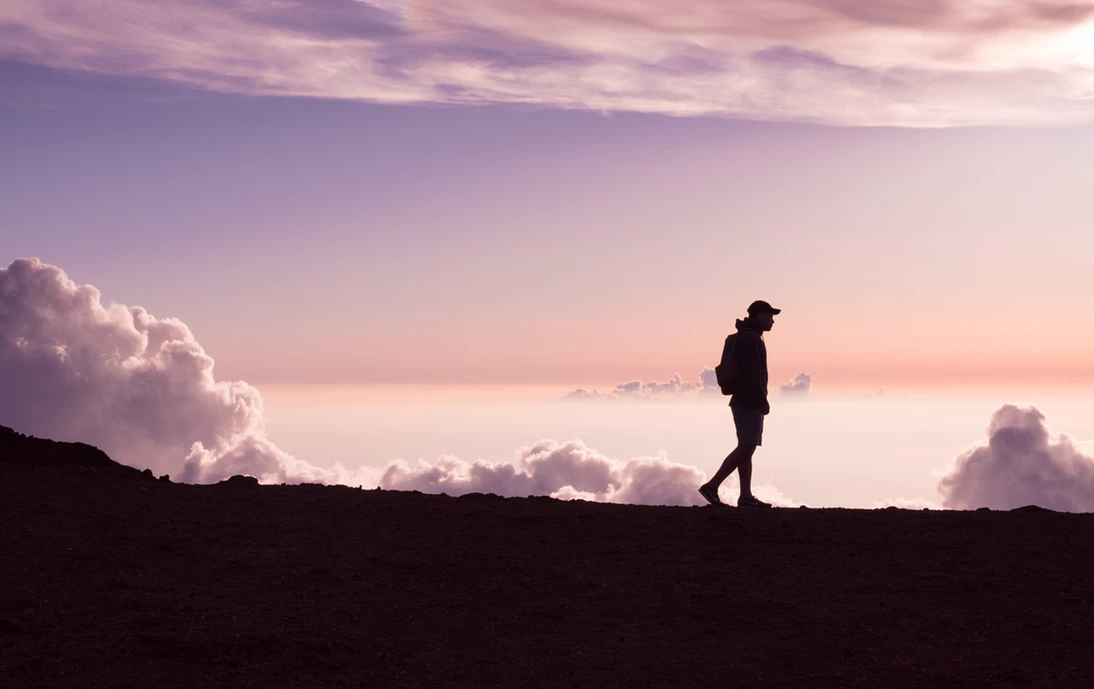
What is a Photo Essay? 9 Photo Essay Examples You Can Recreate
A photo essay is a series of photographs that tell a story. Unlike a written essay, a photo essay focuses on visuals instead of words. With a photo essay, you can stretch your creative limits and explore new ways to connect with your audience. Whatever your photography skill level, you can recreate your own fun and creative photo essay.
9 Photo Essay Examples You Can Recreate
- Photowalk Photo Essay
- Transformation Photo Essay
- Day in the Life Photo Essay
- Event Photo Essay
- Building Photo Essay
- Historic Site or Landmark Photo Essay
- Behind the Scenes Photo Essay
- Family Photo Essay
- Education Photo Essay
Stories are important to all of us. While some people gravitate to written stories, others are much more attuned to visual imagery. With a photo essay, you can tell a story without writing a word. Your use of composition, contrast, color, and perspective in photography will convey ideas and evoke emotions.
To explore narrative photography, you can use basic photographic equipment. You can buy a camera or even use your smartphone to get started. While lighting, lenses, and post-processing software can enhance your photos, they aren’t necessary to achieve good results.
Whether you need to complete a photo essay assignment or want to pursue one for fun or professional purposes, you can use these photo essay ideas for your photography inspiration . Once you know the answer to “what is a photo essay?” and find out how fun it is to create one, you’ll likely be motivated to continue your forays into photographic storytelling.
1 . Photowalk Photo Essay
One popular photo essay example is a photowalk. Simply put, a photowalk is time you set aside to walk around a city, town, or a natural site and take photos. Some cities even have photowalk tours led by professional photographers. On these tours, you can learn the basics about how to operate your camera, practice photography composition techniques, and understand how to look for unique shots that help tell your story.
Set aside at least two to three hours for your photowalk. Even if you’re photographing a familiar place—like your own home town—try to look at it through new eyes. Imagine yourself as a first-time visitor or pretend you’re trying to educate a tourist about the area.
Walk around slowly and look for different ways to capture the mood and energy of your location. If you’re in a city, capture wide shots of streets, close-ups of interesting features on buildings, street signs, and candid shots of people. Look for small details that give the city character and life. And try some new concepts—like reflection picture ideas—by looking for opportunities to photographs reflections in mirrored buildings, puddles, fountains, or bodies of water.
2 . Transformation Photo Essay
With a transformation photography essay, you can tell the story about change over time. One of the most popular photostory examples, a transformation essay can document a mom-to-be’s pregnancy or a child’s growth from infancy into the toddler years. But people don’t need to be the focus of a transformation essay. You can take photos of a house that is being built or an urban area undergoing revitalization.
You can also create a photo narrative to document a short-term change. Maybe you want to capture images of your growing garden or your move from one home to another. These examples of photo essays are powerful ways of telling the story of life’s changes—both large and small.
3 . Day in the Life Photo Essay
Want a unique way to tell a person’s story? Or, perhaps you want to introduce people to a career or activity. You may want to consider a day in the life essay.
With this photostory example, your narrative focuses on a specific subject for an entire day. For example, if you are photographing a farmer, you’ll want to arrive early in the morning and shadow the farmer as he or she performs daily tasks. Capture a mix of candid shots of the farmer at work and add landscapes and still life of equipment for added context. And if you are at a farm, don’t forget to get a few shots of the animals for added character, charm, or even a dose of humor. These types of photography essay examples are great practice if you are considering pursuing photojournalism. They also help you learn and improve your candid portrait skills.
4 . Event Photo Essay
Events are happening in your local area all the time, and they can make great photo essays. With a little research, you can quickly find many events that you could photograph. There may be bake sales, fundraisers, concerts, art shows, farm markets, block parties, and other non profit event ideas . You could also focus on a personal event, such as a birthday or graduation.
At most events, your primary emphasis will be on capturing candid photos of people in action. You can also capture backgrounds or objects to set the scene. For example, at a birthday party, you’ll want to take photos of the cake and presents.
For a local or community event, you can share your photos with the event organizer. Or, you may be able to post them on social media and tag the event sponsor. This is a great way to gain recognition and build your reputation as a talented photographer.
5. Building Photo Essay
Many buildings can be a compelling subject for a photographic essay. Always make sure that you have permission to enter and photograph the building. Once you do, look for interesting shots and angles that convey the personality, purpose, and history of the building. You may also be able to photograph the comings and goings of people that visit or work in the building during the day.
Some photographers love to explore and photograph abandoned buildings. With these types of photos, you can provide a window into the past. Definitely make sure you gain permission before entering an abandoned building and take caution since some can have unsafe elements and structures.
6. Historic Site or Landmark Photo Essay
Taking a series of photos of a historic site or landmark can be a great experience. You can learn to capture the same site from different angles to help portray its character and tell its story. And you can also photograph how people visit and engage with the site or landmark. Take photos at different times of day and in varied lighting to capture all its nuances and moods.
You can also use your photographic essay to help your audience understand the history of your chosen location. For example, if you want to provide perspective on the Civil War, a visit to a battleground can be meaningful. You can also visit a site when reenactors are present to share insight on how life used to be in days gone by.
7 . Behind the Scenes Photo Essay
Another fun essay idea is taking photos “behind the scenes” at an event. Maybe you can chronicle all the work that goes into a holiday festival from the early morning set-up to the late-night teardown. Think of the lead event planner as the main character of your story and build the story about him or her.
Or, you can go backstage at a drama production. Capture photos of actors and actresses as they transform their looks with costuming and makeup. Show the lead nervously pacing in the wings before taking center stage. Focus the work of stagehands, lighting designers, and makeup artists who never see the spotlight but bring a vital role in bringing the play to life.
8. Family Photo Essay
If you enjoy photographing people, why not explore photo story ideas about families and relationships? You can focus on interactions between two family members—such as a father and a daughter—or convey a message about a family as a whole.
Sometimes these type of photo essays can be all about the fun and joy of living in a close-knit family. But sometimes they can be powerful portraits of challenging social topics. Images of a family from another country can be a meaningful photo essay on immigration. You could also create a photo essay on depression by capturing families who are coping with one member’s illness.
For these projects on difficult topics, you may want to compose a photo essay with captions. These captions can feature quotes from family members or document your own observations. Although approaching hard topics isn’t easy, these types of photos can have lasting impact and value.
9. Education Photo Essay
Opportunities for education photo essays are everywhere—from small preschools to community colleges and universities. You can seek permission to take photos at public or private schools or even focus on alternative educational paths, like homeschooling.
Your education photo essay can take many forms. For example, you can design a photo essay of an experienced teacher at a high school. Take photos of him or her in action in the classroom, show quiet moments grading papers, and capture a shared laugh between colleagues in the teacher’s lounge.
Alternatively, you can focus on a specific subject—such as science and technology. Or aim to portray a specific grade level, document activities club or sport, or portray the social environment. A photo essay on food choices in the cafeteria can be thought-provoking or even funny. There are many potential directions to pursue and many great essay examples.
While education is an excellent topic for a photo essay for students, education can be a great source of inspiration for any photographer.
Why Should You Create a Photo Essay?
Ultimately, photographers are storytellers. Think of what a photographer does during a typical photo shoot. He or she will take a series of photos that helps convey the essence of the subject—whether that is a person, location, or inanimate object. For example, a family portrait session tells the story of a family—who they are, their personalities, and the closeness of their relationship.
Learning how to make a photo essay can help you become a better storyteller—and a better photographer. You’ll cultivate key photography skills that you can carry with you no matter where your photography journey leads.
If you simply want to document life’s moments on social media, you may find that a single picture doesn’t always tell the full story. Reviewing photo essay examples and experimenting with your own essay ideas can help you choose meaningful collections of photos to share with friends and family online.
Learning how to create photo essays can also help you work towards professional photography ambitions. You’ll often find that bloggers tell photographic stories. For example, think of cooking blogs that show you each step in making a recipe. Photo essays are also a mainstay of journalism. You’ll often find photo essays examples in many media outlets—everywhere from national magazines to local community newspapers. And the best travel photographers on Instagram tell great stories with their photos, too.
With a photo essay, you can explore many moods and emotions. Some of the best photo essays tell serious stories, but some are humorous, and others aim to evoke action.
You can raise awareness with a photo essay on racism or a photo essay on poverty. A photo essay on bullying can help change the social climate for students at a school. Or, you can document a fun day at the beach or an amusement park. You have control of the themes, photographic elements, and the story you want to tell.
5 Steps to Create a Photo Essay
Every photo essay will be different, but you can use a standard process. Following these five steps will guide you through every phase of your photo essay project—from brainstorming creative essay topics to creating a photo essay to share with others.
Step 1: Choose Your Photo Essay Topics
Just about any topic you can imagine can form the foundation for a photo essay. You may choose to focus on a specific event, such as a wedding, performance, or festival. Or you may want to cover a topic over a set span of time, such as documenting a child’s first year. You could also focus on a city or natural area across the seasons to tell a story of changing activities or landscapes.
Since the best photo essays convey meaning and emotion, choose a topic of interest. Your passion for the subject matter will shine through each photograph and touch your viewer’s hearts and minds.
Step 2: Conduct Upfront Research
Much of the work in a good-quality photo essay begins before you take your first photo. It’s always a good idea to do some research on your planned topic.
Imagine you’re going to take photos of a downtown area throughout the year. You should spend some time learning the history of the area. Talk with local residents and business owners and find out about planned events. With these insights, you’ll be able to plan ahead and be prepared to take photos that reflect the area’s unique personality and lifestyles.
For any topic you choose, gather information first. This may involve internet searches, library research, interviews, or spending time observing your subject.
Step 3: Storyboard Your Ideas
After you have done some research and have a good sense of the story you want to tell, you can create a storyboard. With a storyboard, you can write or sketch out the ideal pictures you want to capture to convey your message.
You can turn your storyboard into a “shot list” that you can bring with you on site. A shot list can be especially helpful when you are at a one-time event and want to capture specific shots for your photo essay. If you’ve never created a photo essay before, start with ten shot ideas. Think of each shot as a sentence in your story. And aim to make each shot evoke specific ideas or emotions.
Step 4: Capture Images
Your storyboard and shot list will be important guides to help you make the most of each shoot. Be sure to set aside enough time to capture all the shots you need—especially if you are photographing a one-time event. And allow yourself to explore your ideas using different photography composition, perspective, and color contrast techniques.
You may need to take a hundred images or more to get ten perfect ones for your photographic essay. Or, you may find that you want to add more photos to your story and expand your picture essay concept.
Also, remember to look for special unplanned, moments that help tell your story. Sometimes, spontaneous photos that aren’t on your shot list can be full of meaning. A mix of planning and flexibility almost always yields the best results.
Step 5: Edit and Organize Photos to Tell Your Story
After capturing your images, you can work on compiling your photo story. To create your photo essay, you will need to make decisions about which images portray your themes and messages. At times, this can mean setting aside beautiful images that aren’t a perfect fit. You can use your shot list and storyboard as a guide but be open to including photos that weren’t in your original plans.
You may want to use photo editing software—such as Adobe Lightroom or Photoshop— to enhance and change photographs. With these tools, you can adjust lighting and white balance, perform color corrections, crop, or perform other edits. If you have a signature photo editing style, you may want to use Photoshop Actions or Lightroom Presets to give all your photos a consistent look and feel.
You order a photo book from one of the best photo printing websites to publish your photo story. You can add them to an album on a photo sharing site, such as Flickr or Google Photos. Also, you could focus on building a website dedicated to documenting your concepts through visual photo essays. If so, you may want to use SEO for photographers to improve your website’s ranking in search engine results. You could even publish your photo essay on social media. Another thing to consider is whether you want to include text captures or simply tell your story through photographs.
Choose the medium that feels like the best space to share your photo essay ideas and vision with your audiences. You should think of your photo essay as your own personal form of art and expression when deciding where and how to publish it.
Photo Essays Can Help You Become a Better Photographer
Whatever your photography ambitions may be, learning to take a photo essay can help you grow. Even simple essay topics can help you gain skills and stretch your photographic limits. With a photo essay, you start to think about how a series of photographs work together to tell a complete story. You’ll consider how different shots work together, explore options for perspective and composition, and change the way you look at the world.
Before you start taking photos, you should review photo essay examples. You can find interesting pictures to analyze and photo story examples online, in books, or in classic publications, like Life Magazine . Don’t forget to look at news websites for photojournalism examples to broaden your perspective. This review process will help you in brainstorming simple essay topics for your first photo story and give you ideas for the future as well.
Ideas and inspiration for photo essay topics are everywhere. You can visit a park or go out into your own backyard to pursue a photo essay on nature. Or, you can focus on the day in the life of someone you admire with a photo essay of a teacher, fireman, or community leader. Buildings, events, families, and landmarks are all great subjects for concept essay topics. If you are feeling stuck coming up with ideas for essays, just set aside a few hours to walk around your city or town and take photos. This type of photowalk can be a great source of material.
You’ll soon find that advanced planning is critical to your success. Brainstorming topics, conducting research, creating a storyboard, and outlining a shot list can help ensure you capture the photos you need to tell your story. After you’ve finished shooting, you’ll need to decide where to house your photo essay. You may need to come up with photo album title ideas, write captions, and choose the best medium and layout.
Without question, creating a photo essay can be a valuable experience for any photographer. That’s true whether you’re an amateur completing a high school assignment or a pro looking to hone new skills. You can start small with an essay on a subject you know well and then move into conquering difficult ideas. Maybe you’ll want to create a photo essay on mental illness or a photo essay on climate change. Or maybe there’s another cause that is close to your heart.
Whatever your passion, you can bring it to life with a photo essay.
Get Contests Via Email for FREE
JOIN OVER 78,852 and receive weekly updates!
WE NEVER SELL OR SHARE YOUR DETAILS
Comments are closed.

Photo Contest Insider
The world’s largest collection of photo contests.
Photo contests are manually reviewed by our team to ensure only the very best make it on to our website. It’s our policy to only list photo contests that are fair.

Subscription
Register now to get updates on promotions and offers
DISCLAIMER:
- Photo Contest Filter
- Get FREE Contest Updates
Photo Contest Insider © 2009 - 2024
Advertise Submit Badges Help Terms Privacy Unsubscribe Do Not Sell My Information Back to Top -->
- PRO Courses Guides New Tech Help Pro Expert Videos About wikiHow Pro Upgrade Sign In
- EDIT Edit this Article
- EXPLORE Tech Help Pro About Us Random Article Quizzes Request a New Article Community Dashboard This Or That Game Forums Popular Categories Arts and Entertainment Artwork Books Movies Computers and Electronics Computers Phone Skills Technology Hacks Health Men's Health Mental Health Women's Health Relationships Dating Love Relationship Issues Hobbies and Crafts Crafts Drawing Games Education & Communication Communication Skills Personal Development Studying Personal Care and Style Fashion Hair Care Personal Hygiene Youth Personal Care School Stuff Dating All Categories Arts and Entertainment Finance and Business Home and Garden Relationship Quizzes Cars & Other Vehicles Food and Entertaining Personal Care and Style Sports and Fitness Computers and Electronics Health Pets and Animals Travel Education & Communication Hobbies and Crafts Philosophy and Religion Work World Family Life Holidays and Traditions Relationships Youth
- Browse Articles
- Learn Something New
- Quizzes Hot
- Happiness Hub
- This Or That Game
- Train Your Brain
- Explore More
- Support wikiHow
- About wikiHow
- Log in / Sign up
- Education and Communications
- College University and Postgraduate
- Academic Writing
How to Make a Photo Essay
Last Updated: September 27, 2023 Fact Checked
This article was co-authored by Heather Gallagher . Heather Gallagher is a Photojournalist & Photographer based in Austin, Texas. She runs her own photography studio named "Heather Gallagher Photography" which was voted Austin's Best Family Photographer and top 3 Birth Photographers in 2017, 2018, and 2019. Heather specializes in family Photojournalism and has over 15 years of experience documenting individuals, families, and businesses all over the world. Her clients include Delta Airlines, Oracle, Texas Monthly, and her work has been featured in The Washington Post and The Austin American Statesman. She is a member of the International Association of Professional Birth Photographers (IAPBP). There are 11 references cited in this article, which can be found at the bottom of the page. This article has been fact-checked, ensuring the accuracy of any cited facts and confirming the authority of its sources. This article has been viewed 293,152 times.
Photo essays are an increasingly popular medium for journalists, bloggers, and advertisers alike. Whether you’re trying to show the emotional impact of a current news story or share your hobby with friends and family, images can capture your topic in a personal, emotional, and interesting way. Creating a photo essay can be as easy as choosing a topic, getting your images, and organizing the essay.
Things You Should Know
- Reflect long and hard on your topic, considering your audience, current events, and whether to go for a thematic or narrative approach.
- Create an outline, including your focus image, establishing shot, clincher, and other image details.
- When you finally take your photos, remember to take more photos than you think you need and don't be afraid to let the project change as you create it.
Finding Your Topic

- Offer a photo essay of your place of business as a training tool.
- Use a photo essay about your business as a sales or social tool by publishing it on your website or social media page.
- Create a how to photo essay to help others learn about your hobby, so they can take it up as well. [4] X Research source

- Thematic subjects are big ideas including things like local gun laws, at-risk youth, or welcoming home soldiers.
- Narrative essays can include a day in the life, how to tutorials, or progression series that show changes over time such as tracking a building project.
- If you have been given a commission or specific publication to work with, you may need to choose a topic that will fit a thematic or narrative approach as outlined by the publication. Make sure you are aware of any publication guidelines in advance.
Organizing Your Shoot

- Consider how difficult it will be to get permission to photograph your subjects. If you already have relationships established, it will be easier. If not, allow for extra time to get permission and/or waivers.
- Schools, daycares, and other places with kids typically have more regulations on who can be photographed and for what purposes. You’ll usually need to get parental approval, in addition to permission from those in charge. [7] X Research source

- Consider doing interviews with people involved prior to the shoot. Ask things like, “What’s the most interesting thing you do during this event?” or “How long have you been involved with this organization?”
- These interviews are also a great opportunity to ask for permission and get waivers.
- If you’re going to visit a job site, charitable event, or other large group activity, ask the person or persons in charge to explain what you’re doing to everyone before you arrive. [8] X Research source

Capturing Your Images

- Many new photographers stay away from high ISO shots because they allow more light through producing a “busy” image. However, these images are often easier to edit later as there’s more information to work with. [11] X Research source
- If it’s very bright in your location or you’ve set up artificial lighting, a low ISO is likely adequate, For darker areas, you’ll likely need to use a higher ISO.
- If you need one second to capture an image with a base ISO of 100, you’ll need one eighth of a second to capture with an ISO of 800. [13] X Research source

- Even snapping candid shots, which you may need to capture quickly, take a few moments to think about how objects are placed to make the most impact.
- Always think about how the main subject’s surroundings play into the overall image, and try to create different levels and points of interest.
- You can change composition as part of the editing process in some cases, so if you can’t line up the shot just right, don’t let it deter you from capturing the image you want. [14] X Research source

Organizing the Essay

- If you’re doing a day in the life photo essay about a frustrated person working in an office, an image of that person struggling to open the front door against the wind might be an apt focus shot.
- If your essay is about the process of building a home, your focus image may be something like a contractor and architect looking at blue prints with the framed up home in the background.
- If your essay is about a family reunion, the focus image may be a funny shot of the whole family making faces, pretending to be fighting, or a serious photo of the family posed together. Capture whatever seems natural for the family. [18] X Research source

- Regardless of essay type, you’ll need a focus image to grab attention.
- Use an overall shot to give context to your essay. Where is it, when is it happening, who’s involved, what’s going on, and why should someone be interested? The five “W’s” of journalism are a great way to determine what your overall shot should capture.
- Find your final image. This should be something provocative that asks your viewer to think about the topic.
- Between the focus and overall shot and ending image, include a series of images that move the viewer from the lead-in shots to its result. Use images that build in intensity or draw the viewers further into the essay.

- If the images aren’t telling the story, ask your friends to look at your other photos and ask, “I wanted this image to make this point. You got a different idea. Would any of these images make this point to you more clearly?”
- If the others like the images you’ve chosen, you may still want to ask them to look at your other photos and tell you if they think any of the images you didn’t include should be added in. They may see something you missed. [20] X Research source

- If you're commissioned to add photos to an essay, you should make sure images reflect the written word, but also add emotion and context the writing could not capture. For example, an essay on poverty may include an image of a child and parent living on the street could capture more emotional context.
- Captions should only include information the viewer could not derive from the photo itself. For instance, you can include a date, the subject’s name, or a statistic relevant to your subject in the caption.
- If you choose not to have any text or just a title and some introductory and/or closing words, make sure you convey all necessary information succinctly. [21] X Research source
Expert Q&A

- Be creative with your topics. However, something as simple as "things I like" will suffice so long as you stay creative. Thanks Helpful 0 Not Helpful 0
- Make sure you're familiar with your camera. It will make the photo composition a lot easier. Thanks Helpful 0 Not Helpful 0
- Don't get discouraged. It may take several tries to get the desired results in your photos. Thanks Helpful 1 Not Helpful 0

You Might Also Like

- ↑ http://digital-photography-school.com/5-photo-essay-tips/
- ↑ Heather Gallagher. Professional Photojournalist & Photographer. Expert Interview. 8 April 2020.
- ↑ http://improvephotography.com/30816/10-ideas-creative-photo-essays/
- ↑ http://www.apogeephoto.com/how-to-create-a-photo-essay/
- ↑ https://petapixel.com/how-to-create-a-photo-essay/
- ↑ http://photo.journalism.cuny.edu/week-5/
- ↑ http://clickitupanotch.com/2010/12/creating-a-photo-essay/
- ↑ https://photographylife.com/what-is-iso-in-photography
- ↑ https://wiredimpact.com/blog/how-to-make-a-photo-essay-nonprofit/
- ↑ http://digital-photography-school.com/5-tips-for-creating-a-photo-essay-with-a-purpose/
- ↑ https://www.format.com/magazine/resources/photography/how-to-make-photo-essay-examples
About This Article

To make a photo essay, start by selecting a subject that is easy to capture and that inspires you, like a friend or a family pet. Then, decide if you want to present your photo essay as thematic, which shows specific examples of a big idea, or narrative, with a beginning, middle, and end. Next, create an outline of your essay to determine which photos you’ll need, like an establishing shot. Finally, take your photos, select which images you want to use in your essay, and organize them according to your theme before adding text to explain the essay. To learn how to capture the best images, keep scrolling! Did this summary help you? Yes No
- Send fan mail to authors
Reader Success Stories
Aug 3, 2016
Did this article help you?
Sep 24, 2023
Christopher Ulloa Abarua
Mar 16, 2018

Featured Articles

Trending Articles

Watch Articles

- Terms of Use
- Privacy Policy
- Do Not Sell or Share My Info
- Not Selling Info
Get all the best how-tos!
Sign up for wikiHow's weekly email newsletter

IMAGES
COMMENTS
Jun 7, 2021 · There are plenty of interesting photo essay ideas that offer endless avenues to tell a powerful photo story. Some examples of areas you could cover are: 1. Day-in-the-life photo essay: These kinds of photo essays tell the story of a day in the life of a particular subject. They can showcase the career of a busy farmer or struggling artist ...
A photographic essay or photo-essay for short is a form of visual storytelling, a way to present a narrative through a series of images. A photo essay delivers a story using a series of photographs and brings the viewer along a narrative journey. [1] Examples of photo essays include: A web page or portion of a web site.
Jan 29, 2024 · A photo essay is a collection of images based around a theme, a topic, a creative approach, or an exploration of an idea. Learn the difference between a photo essay and a photo story, and how to make one with examples and tips.
A photo essay is a series of images that share an overarching theme and tell a story. Learn the types, elements, tips and examples of photo essays from this photography guide.
Oct 16, 2024 · Photo essays are widely used in journalism, art, and personal projects to evoke emotions and engage audiences visually. Download Photo Essay Bundle. Photo Essay Format. A photo essay is a series of photographs that are intended to tell a story or evoke a series of emotions in the viewer.
This photo essay shows how the event is filled with excitement and school spirit, celebrating the homecoming game and ushering in the new school year. Here’s the link to read the complete essay. 8 Photo Essay Ideas to Showcase Your Photography Skills. Are you seeking a photo essay topic to get your creative juices flowing?
Aug 21, 2024 · A photo essay is a powerful form of visual storytelling in which a narrative is presented through a series of images. Unlike a written essay, a photo essay relies on visuals to tell a story and evoke emotions within the viewer. When you create a photo essay, you can stretch your creative limits and explore new ways of connecting with your audience.
Aug 22, 2022 · A photo essay is a series of photographs that tell a story without words. Learn what a photo essay is and see 9 examples of different types of photo essays you can recreate with your camera.
Sep 27, 2023 · Photo essays are an increasingly popular medium for journalists, bloggers, and advertisers alike. Whether you’re trying to show the emotional impact of a current news story or share your hobby with friends and family, images can capture your topic in a personal, emotional, and interesting way.
May 3, 2022 · A photo essay is a visual story that uses a series of images to convey a theme, idea, or message. Learn the history, types, and steps of creating a photo essay with examples and tips.